Bangkok
Bangkok .mw-parser-output .nobold{font-weight:normal} กรุงเทพมหานคร Krung Thep Maha Nakhon | |||
|---|---|---|---|
Special administrative area | |||
 Clockwise from top: Si Lom–Sathon business district, the Giant Swing, Victory Monument, Rama VIII Bridge, Wat Arun, and the Grand Palace | |||
| |||
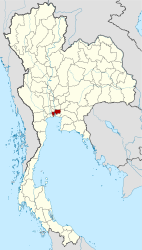 Location within Thailand | |||
| Coordinates: 13°45′09″N 100°29′39″E / 13.75250°N 100.49417°E / 13.75250; 100.49417Coordinates: 13°45′09″N 100°29′39″E / 13.75250°N 100.49417°E / 13.75250; 100.49417[1] | |||
| Country | Thailand | ||
| Region | Central Thailand | ||
| Settled | c. 15th century | ||
| Founded as capital | 21 April 1782 | ||
| Re-incorporated | 13 December 1972 | ||
| Founded by | King Rama I | ||
| Governing body | Bangkok Metropolitan Administration | ||
| Government | |||
| • Type | Special administrative area | ||
| • Governor | Aswin Kwanmuang | ||
| Area [1] | |||
| • City | 1,568.737 km2 (605.693 sq mi) | ||
| • Metro [2] | 7,761.6 km2 (2,996.8 sq mi) | ||
| Elevation [3] | 1.5 m (4.9 ft) | ||
| Population (2010 census)[4][5] | |||
| • City | 8,280,925 | ||
| • Density | 5,300/km2 (14,000/sq mi) | ||
| • Metro | 14,626,225 | ||
| • Metro density | 1,900/km2 (4,900/sq mi) | ||
| Demonym(s) | Bangkokian | ||
| Time zone | UTC+07:00 (ICT) | ||
| Postal code | 10### | ||
| Area code(s) | 02 | ||
| ISO 3166 code | TH-10 | ||
| Website | www.bangkok.go.th | ||
Bangkok (UK: /bæŋˈkɒk/,[6][7]US: /ˈbæŋkɒk/[7][8]) is the capital and most populous city of Thailand. It is known in Thai as Krung Thep Maha Nakhon (กรุงเทพมหานคร, pronounced [krūŋ tʰêːp mahǎː nákʰɔ̄ːn] (![]() listen)) or simply Krung Thep (
listen)) or simply Krung Thep (![]() listen (help·info)). The city occupies 1,568.7 square kilometres (605.7 sq mi) in the Chao Phraya River delta in central Thailand, and has a population of over eight million, or 12.6 percent of the country's population. Over fourteen million people (22.2 percent) lived within the surrounding Bangkok Metropolitan Region at the 2010 census,[5] making Bangkok the nation's primate city, significantly dwarfing Thailand's other urban centres in terms of importance.
listen (help·info)). The city occupies 1,568.7 square kilometres (605.7 sq mi) in the Chao Phraya River delta in central Thailand, and has a population of over eight million, or 12.6 percent of the country's population. Over fourteen million people (22.2 percent) lived within the surrounding Bangkok Metropolitan Region at the 2010 census,[5] making Bangkok the nation's primate city, significantly dwarfing Thailand's other urban centres in terms of importance.
Bangkok traces its roots to a small trading post during the Ayutthaya Kingdom in the 15th century, which eventually grew and became the site of two capital cities: Thonburi in 1768 and Rattanakosin in 1782. Bangkok was at the heart of the modernization of Siam, later renamed Thailand, during the late 19th century, as the country faced pressures from the West. The city was at the centre of Thailand's political struggles throughout the 20th century, as the country abolished absolute monarchy, adopted constitutional rule, and underwent numerous coups and several uprisings. The city grew rapidly during the 1960s through the 1980s and now exerts a significant impact on Thailand's politics, economy, education, media and modern society.
The Asian investment boom in the 1980s and 1990s led many multinational corporations to locate their regional headquarters in Bangkok. The city is now a regional force in finance and business. It is an international hub for transport and health care, and has emerged as a centre for the arts, fashion, and entertainment. The city is known for its vibrant street life and cultural landmarks, as well as its notorious red-light districts. The historic Grand Palace and Buddhist temples including Wat Arun and Wat Pho stand in contrast with other tourist attractions such as the nightlife scenes of Khaosan Road and Patpong. Bangkok is among the world's top tourist destinations, and has been named the world's most visited city in multiple rankings.
Bangkok's rapid growth coupled with little urban planning has resulted in a haphazard cityscape and inadequate infrastructure. An inadequate road network, despite an extensive expressway network, together with substantial private car usage, have led to chronic and crippling traffic congestion, which caused severe air pollution in the 1990s. The city has since turned to public transport in an attempt to solve the problem. Five rapid transit lines are now in operation, with more systems under construction or planned by the national government and the Bangkok Metropolitan Administration.
Contents
1 History
2 Name
3 Government
4 Geography
4.1 Topography
4.2 Climate
4.3 Districts
4.4 Cityscape
4.5 Parks and green zones
5 Demography
6 Economy
7 Tourism
8 Culture
8.1 Festivals and events
8.2 Media
8.3 Art
9 Sport
10 Transport
10.1 Roads
10.2 Buses and taxis
10.3 Rail systems
10.4 Water transport
10.5 Airports
11 Health and education
11.1 Education
11.2 Healthcare
12 Crime and safety
13 International relations
13.1 International participation
13.2 Sister cities
14 See also
15 Notes
16 References
16.1 Bibliography
17 Further reading
18 External links
History

Map of 17th-century Bangkok, from Simon de la Loubère's Du Royaume de Siam
The history of Bangkok dates at least back to the early 15th century, when it was a village on the west bank of the Chao Phraya River, under the rule of Ayutthaya.[9] Because of its strategic location near the mouth of the river, the town gradually increased in importance. Bangkok initially served as a customs outpost with forts on both sides of the river, and became the site of a siege in 1688 in which the French were expelled from Siam. After the fall of Ayutthaya to the Burmese Empire in 1767, the newly declared King Taksin established his capital at the town, which became the base of the Thonburi Kingdom. In 1782, King Phutthayotfa Chulalok (Rama I) succeeded Taksin, moved the capital to the eastern bank's Rattanakosin Island, thus founding the Rattanakosin Kingdom. The City Pillar was erected on 21 April, which is regarded as the date of foundation of the present city.[10]
Bangkok's economy gradually expanded through busy international trade, first with China, then with Western merchants returning in the early-to-mid 19th century. As the capital, Bangkok was the centre of Siam's modernization as it faced pressure from Western powers in the late 19th century. The reigns of Kings Mongkut (Rama IV, 1851–68) and Chulalongkorn (Rama V, 1868–1910) saw the introduction of the steam engine, printing press, rail transport and utilities infrastructure in the city, as well as formal education and healthcare. Bangkok became the centre stage for power struggles between the military and political elite as the country abolished absolute monarchy in 1932. It was subject to Japanese occupation and Allied bombing during World War II, but rapidly grew in the post-war period as a result of United States developmental aid and government-sponsored investment. Bangkok's role as an American military R&R destination boosted its tourism industry as well as firmly establishing it as a sex tourism destination. Disproportionate urban development led to increasing income inequalities and unprecedented migration from rural areas into Bangkok; its population surged from 1.8 million to 3 million in the 1960s. Following the United States' withdrawal from Vietnam in 1973, Japanese businesses took over as leaders in investment, and the expansion of export-oriented manufacturing led to growth of the financial market in Bangkok.[11] Rapid growth of the city continued through the 1980s and early 1990s, until it was stalled by the 1997 Asian financial crisis. By then, many public and social issues had emerged, among them the strain on infrastructure reflected in the city's notorious traffic jams. Bangkok's role as the nation's political stage continues to be seen in strings of popular protests, from the student uprisings in 1973 and 1976, anti-military demonstrations in 1992, and successive anti-government demonstrations by opposing groups from 2008 onwards.
Administration of the city was first formalized by King Chulalongkorn in 1906, with the establishment of Monthon Krung Thep Phra Maha Nakhon (มณฑลกรุงเทพพระมหานคร) as a national subdivision. In 1915 the monthon was split into several provinces, the administrative boundaries of which have since further changed. The city in its current form was created in 1972 with the formation of the Bangkok Metropolitan Administration (BMA), following the merger of Phra Nakhon Province on the eastern bank of the Chao Phraya and Thonburi Province on the west during the previous year.[10]
Name
The origin of the name Bangkok (บางกอก, pronounced in Thai as [bāːŋ kɔ̀ːk] (![]() listen)), is unclear. Bang is a Thai word meaning 'a village on a stream',[12] and the name might have been derived from Bang Ko (บางเกาะ), ko meaning 'island', stemming from the city's watery landscape.[9] Another theory suggests that it is shortened from Bang Makok (บางมะกอก), makok being the name of Elaeocarpus hygrophilus, a plant bearing olive-like fruit.[a] This is supported by the former name of Wat Arun, a historic temple in the area, that used to be called Wat Makok.[13] Officially, the town was known as Thonburi Si Mahasamut (ธนบุรีศรีมหาสมุทร, from Pali and Sanskrit, literally 'city of treasures gracing the ocean') or Thonburi, according to the Ayutthaya Chronicles.[14]Bangkok was likely a colloquial name, albeit one widely adopted by foreign visitors, who continued to use it to refer to the city even after the new capital's establishment.
listen)), is unclear. Bang is a Thai word meaning 'a village on a stream',[12] and the name might have been derived from Bang Ko (บางเกาะ), ko meaning 'island', stemming from the city's watery landscape.[9] Another theory suggests that it is shortened from Bang Makok (บางมะกอก), makok being the name of Elaeocarpus hygrophilus, a plant bearing olive-like fruit.[a] This is supported by the former name of Wat Arun, a historic temple in the area, that used to be called Wat Makok.[13] Officially, the town was known as Thonburi Si Mahasamut (ธนบุรีศรีมหาสมุทร, from Pali and Sanskrit, literally 'city of treasures gracing the ocean') or Thonburi, according to the Ayutthaya Chronicles.[14]Bangkok was likely a colloquial name, albeit one widely adopted by foreign visitors, who continued to use it to refer to the city even after the new capital's establishment.
When King Rama I established his new capital on the river's eastern bank, the city inherited Ayutthaya's ceremonial name, of which there were many variants, including Krung Thep Thawarawadi Si Ayutthaya (กรุงเทพทวารวดีศรีอยุธยา) and Krung Thep Maha Nakhon Si Ayutthaya (กรุงเทพมหานครศรีอยุธยา).[15]Edmund Roberts, visiting the city as envoy of the United States in 1833, noted that the city, since becoming capital, was known as Sia-Yut'hia, and this is the name used in international treaties of the period.[16] Today, the city is known in Thai as Krung Thep Maha Nakhon (กรุงเทพมหานคร) or simply as Krung Thep (กรุงเทพฯ). Its full ceremonial name, which came into use during the reign of King Mongkut, reads as follows:[b][10]
 | Full ceremonial name |
Problems playing this file? See media help. | |
.mw-parser-output .templatequote{overflow:hidden;margin:1em 0;padding:0 40px}.mw-parser-output .templatequote .templatequotecite{line-height:1.5em;text-align:left;padding-left:1.6em;margin-top:0}
Krungthepmahanakhon Amonrattanakosin Mahintharayutthaya Mahadilokphop Noppharatratchathaniburirom Udomratchaniwetmahasathan Amonphimanawatansathit Sakkathattiyawitsanukamprasit[c]
กรุงเทพมหานคร อมรรัตนโกสินทร์ มหินทรายุธยา มหาดิลกภพ นพรัตนราชธานีบูรีรมย์ อุดมราชนิเวศน์มหาสถาน อมรพิมานอวตารสถิต สักกะทัตติยวิษณุกรรมประสิทธิ์
The name, composed of Pali and Sanskrit root words, translates as:
City of angels, great city of immortals, magnificent city of the nine gems, seat of the king, city of royal palaces, home of gods incarnate, erected by Vishvakarman at Indra's behest.[17]
 | "Krung Thep Maha Nakhon" (1989) by Asanee–Wasan |
Problems playing this file? See media help. | |
The name is listed in Guinness World Records as the world's longest place name, at 168 letters.[18] Thai school children are taught the full name, although few can explain its meaning as many of the words are archaic, and known to few. Most Thais who recall the full name do so because of its use in a popular song, "Krung Thep Maha Nakhon" (1989) by Asanee–Wasan and will often recount it by singing it,[citation needed] much as an English speaker might sing the alphabet song to recite the alphabet. The entirety of the lyrics is just the name of the city repeated over and over.
The city is now officially known in Thai by a shortened form of the full ceremonial name, Krung Thep Maha Nakhon, which is colloquially further shortened to Krung Thep. Bangkok is the city's official English name, as reflected in the name of the Bangkok Metropolitan Administration.
Government

The city's ceremonial name (partially visible) is displayed in front of the Bangkok City Hall. On the building is the BMA seal bearing an image of Indra riding Erawan.
The city of Bangkok is locally governed by the Bangkok Metropolitan Administration (BMA). Although its boundaries are at the provincial (changwat) level, unlike the other 76 provinces Bangkok is a special administrative area whose governor is directly elected to serve a four-year term. The governor, together with four appointed deputies, form the executive body, who implement policies through the BMA civil service headed by the Permanent Secretary for the BMA. In separate elections, each district elects one or more city councillors, who form the Bangkok Metropolitan Council. The council is the BMA's legislative body, and has power over municipal ordinances and the city's budget.[19] However, after the coup of 2014 all local elections have been cancelled and the council was appointed by the government on 15 September 2014. The current Bangkok Governor is Police General Aswin Kwanmuang, who was appointed by the military government on 26 October 2016[20] following the suspension of the last elected governor M.R. Sukhumbhand Paribatra.
Bangkok is subdivided into fifty districts (khet, equivalent to amphoe in the other provinces), which are further subdivided into 180 subdistricts (khwaeng, equivalent to tambon). Each district is managed by a district director appointed by the governor. District councils, elected to four-year terms, serve as advisory bodies to their respective district directors.
The BMA is divided into sixteen departments, each overseeing different aspects of the administration's responsibilities. Most of these responsibilities concern the city's infrastructure, and include city planning, building control, transportation, drainage, waste management and city beautification, as well as education, medical and rescue services.[21] Many of these services are provided jointly with other agencies. The BMA has the authority to implement local ordinances, although civil law enforcement falls under the jurisdiction of the Metropolitan Police Bureau.
The seal of the city shows Hindu god Indra riding in the clouds on Airavata, a divine white elephant known in Thai as Erawan. In his hand Indra holds his weapon, the vajra.[22] The seal is based on a painting done by Prince Naris. The tree symbol of Bangkok is Ficus benjamina.[23] The official city slogan, adopted in 2012, reads:
As built by deities, the administrative center, dazzling palaces and temples, the capital of Thailand
กรุงเทพฯ ดุจเทพสร้าง เมืองศูนย์กลางการปกครอง วัดวังงามเรืองรอง เมืองหลวงของประเทศไทย[24]
As the capital of Thailand, Bangkok is the seat of all branches of the national government. The Government House, Parliament House and Supreme, Administrative and Constitutional Courts are all located within the city. Bangkok is the site of the Grand Palace and Chitralada Villa, respectively the official and de facto residence of the king. Most government ministries also have headquarters and offices in the capital.
Geography

The Bangkok city proper is highlighted in this satellite image of the lower Chao Phraya delta. Notice the built-up urban area along the Chao Phraya River, which extends northward and southward into Nonthaburi and Samut Prakan Provinces.
Bangkok city proper covers an area of 1,568.7 square kilometres (605.7 sq mi), ranking 69th among the other 76 provinces of Thailand. Of this, about 700 square kilometres (270 sq mi) form the built-up urban area.[1] It is ranked 73rd in the world in terms of land area by City Mayors.[25] The city's urban sprawl reaches into parts of the six other provinces it borders, namely, in clockwise order from northwest: Nonthaburi, Pathum Thani, Chachoengsao, Samut Prakan, Samut Sakhon and Nakhon Pathom. With the exception of Chachoengsao, these provinces, together with Bangkok, form the greater Bangkok Metropolitan Region.[2]
Topography
Bangkok is in the Chao Phraya River delta in Thailand's central plains. The river meanders through the city in a southward direction, emptying into the Gulf of Thailand approximately 25 kilometres (16 mi) south of the city centre. The area is flat and low-lying, with an average elevation of 1.5 metres (4 ft 11 in) above sea level.[3][d]
Most of the area was originally swampland, which was gradually drained and irrigated for agriculture via the construction of canals (khlong) which took place throughout the 16th to 19th centuries. The course of the river as it flows through Bangkok has been modified by the construction of several shortcut canals.
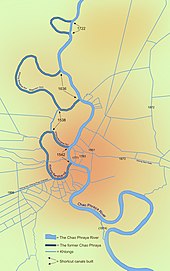
Bangkok's major canals are shown in this map detailing the original course of the river and its shortcut canals.
This intricate waterway network served as the primary mode of transport up until the late 19th century, when modern roads began to be built. Up until then, most people lived near or on the water, leading the city to be known during the 19th century as the "Venice of the East".[26] Many of these canals have since been filled in or paved over, but others still criss-cross the city, serving as major drainage channels and transport routes. Most canals are now badly polluted, although the BMA has committed to the treatment and cleaning up of several canals.[27]
The geology of the Bangkok area is characterized by a top layer of soft marine clay known as Bangkok clay, averaging 15 metres (49 ft) in thickness, which overlies an aquifer system consisting of eight known units. This feature has contributed to the effects of subsidence caused by extensive ground water pumping. First recognized in the 1970s, subsidence soon became a critical issue, reaching a rate of 120 millimetres (4.7 in) per year in 1981. Ground water management and mitigation measures have since lessened the severity of the situation, although subsidence is still occurring at a rate of 10 to 30 millimetres (0.39 to 1.18 in) per year, and parts of the city are now 1 metre (3 ft 3 in) below sea level.[28] There are fears that the city may be submerged by 2030.[29][30][31]
Subsidence has resulted in increased flood risk, as Bangkok is already prone to flooding due to its low elevation and inadequate drainage infrastructure resulting from rapid urbanization. The city now relies on flood barriers and augmenting drainage from canals by pumping and building drain tunnels, but parts of Bangkok and its suburbs are still regularly affected by flooding. Heavy downpours resulting in urban runoff overwhelming drainage systems, and runoff discharge from upstream areas, are major triggering factors.[32] Severe flooding affecting much of the city occurred recently in 1995 and 2011. In the latter, most of Bangkok's northern, eastern and western districts became inundated, in some places for over two months. Coastal erosion is also an issue in the gulf coastal area, a small length of which lies within Bangkok's Bang Khun Thian District. Global warming poses further serious risks, and a study by the OECD has estimated that 5.138 million people in Bangkok may be exposed to coastal flooding by 2070, the seventh highest among the world's port cities.[33]:8
There are no mountains in Bangkok, the closest mountain range being the Khao Khiao Massif, located about 40 km (25 mi) southeast of the city. Phu Khao Thong, the only hill in the metropolitan area, originated in a very large chedi that King Rama III (1787–1851) decided to build at Wat Saket. The chedi collapsed during construction because the soft soil of Bangkok could not support the weight. Over the next few decades, the abandoned mud-and-brick structure acquired the shape of a natural hill and became overgrown with weeds. The locals called it "phu khao" (ภูเขา), as if it were a natural feature.[34] In the 1940s surrounding concrete walls were added to stop the hill from eroding.[35]
Climate
Like most of Thailand, Bangkok has a tropical savanna climate under the Köppen climate classification and is under the influence of the South Asian monsoon system. It experiences three seasons: hot, rainy, and cool, although temperatures are fairly hot year-round, ranging from an average low of 22.0 °C (71.6 °F) in December to an average high of 35.4 °C (95.7 °F) in April. The rainy season begins with the arrival of the southwest monsoon around mid-May. September is the wettest month, with an average rainfall of 334.3 millimetres (13.16 in). The rainy season lasts until October, when the dry and cool northeast monsoon takes over until February. The hot season is generally dry, but also sees occasional summer storms.[36] The surface magnitude of Bangkok's urban heat island has been measured at 2.5 °C (4.5 °F) during the day and 8.0 °C (14 °F) at night.[37] The highest recorded temperature of Bangkok metropolis was 40.1 °C (104.2 °F) in March 2013,[38] and the lowest recorded temperature was 9.9 °C (49.8 °F) in January 1955.[39]
The Climate Impact Group at NASA's Goddard Institute for Space Studies analyzed climate data for major cities worldwide. It found that Bangkok in 1960 had 193 days at or above 32 °C. In 2018, Bangkok can expect 276 days at or above 32 °C. The group forecasts a rise by 2100 to, on average, 297 to 344 days at or above 32 °C.[40]
| Climate data for Bangkok Metropolis (1981–2010) | |||||||||||||
|---|---|---|---|---|---|---|---|---|---|---|---|---|---|
| Month | Jan | Feb | Mar | Apr | May | Jun | Jul | Aug | Sep | Oct | Nov | Dec | Year |
| Record high °C (°F) | 37.6 (99.7) | 38.8 (101.8) | 40.1 (104.2) | 40.2 (104.4) | 39.7 (103.5) | 38.3 (100.9) | 37.9 (100.2) | 38.5 (101.3) | 37.2 (99) | 37.9 (100.2) | 38.8 (101.8) | 37.1 (98.8) | 40.2 (104.4) |
| Average high °C (°F) | 32.5 (90.5) | 33.3 (91.9) | 34.3 (93.7) | 35.4 (95.7) | 34.4 (93.9) | 33.6 (92.5) | 33.2 (91.8) | 32.9 (91.2) | 32.8 (91) | 32.6 (90.7) | 32.4 (90.3) | 31.7 (89.1) | 33.3 (91.9) |
| Daily mean °C (°F) | 27.0 (80.6) | 28.3 (82.9) | 29.5 (85.1) | 30.5 (86.9) | 29.9 (85.8) | 29.5 (85.1) | 29.0 (84.2) | 28.8 (83.8) | 28.3 (82.9) | 28.1 (82.6) | 27.8 (82) | 26.5 (79.7) | 28.6 (83.5) |
| Average low °C (°F) | 22.6 (72.7) | 24.4 (75.9) | 25.9 (78.6) | 26.9 (80.4) | 26.3 (79.3) | 26.1 (79) | 25.7 (78.3) | 25.5 (77.9) | 25.0 (77) | 24.8 (76.6) | 23.9 (75) | 22.0 (71.6) | 24.9 (76.8) |
| Record low °C (°F) | 10.0 (50) | 14.0 (57.2) | 15.7 (60.3) | 20.0 (68) | 21.1 (70) | 21.1 (70) | 21.8 (71.2) | 21.8 (71.2) | 21.1 (70) | 18.3 (64.9) | 15.0 (59) | 10.5 (50.9) | 10 (50) |
| Average rainfall mm (inches) | 13.3 (0.524) | 20.0 (0.787) | 42.1 (1.657) | 91.4 (3.598) | 247.7 (9.752) | 157.1 (6.185) | 175.1 (6.894) | 219.3 (8.634) | 334.3 (13.161) | 292.1 (11.5) | 49.5 (1.949) | 6.3 (0.248) | 1,648.2 (64.89) |
| Average rainy days | 1.8 | 2.4 | 3.6 | 6.6 | 16.4 | 16.3 | 17.4 | 19.6 | 21.2 | 17.7 | 5.8 | 1.1 | 129.9 |
| Average relative humidity (%) | 68 | 72 | 72 | 72 | 75 | 74 | 75 | 76 | 79 | 78 | 70 | 66 | 73 |
| Mean monthly sunshine hours | 272.5 | 249.9 | 269.0 | 256.7 | 216.4 | 178.0 | 171.8 | 160.3 | 154.9 | 198.1 | 234.2 | 262.0 | 2,623.8 |
| Source #1: Thai Meteorological Department,[41] humidity (1981–2010): RID;[42] Rainfall (1981–2010): RID[43] | |||||||||||||
| Source #2: Pogodaiklimat.ru(High/Low Record)[44] NOAA (sun, 1961–1990)[45] | |||||||||||||
Districts
Bangkok's fifty districts serve as administrative subdivisions under the authority of the BMA. Thirty-five of these districts lie to the east of the Chao Phraya, while fifteen are on the western bank, known as the Thonburi side of the city. The fifty districts, arranged by district code, are:[46]
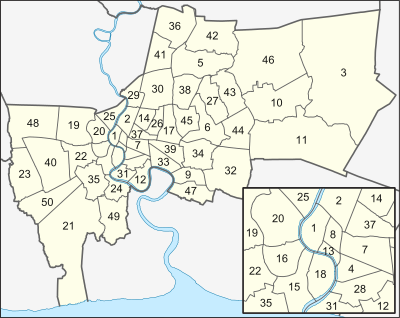
Map showing the 50 districts of Bangkok
|
|
The BMA uses several schemes to organize the districts into groups for administrative and general planning purposes. The scheme adopted in 2004 used twelve characteristic groups.
Cityscape
Bangkok's district areas often do not accurately represent the functional divisions of its neighbourhoods or actual land uses. Although urban planning policies date back to the commission of the "Litchfield plan" in 1960, which set out strategies for land use, transportation and general infrastructure improvements, actual zoning regulations were not fully implemented until 1992. As a result, the city grew organically throughout the period of its rapid expansion, both horizontally as ribbon developments extended along newly built roads, and vertically, with increasing numbers of high rises and skyscrapers being built in several commercial areas.[47] The city has grown from its original centre along the river into a sprawling metropolis surrounded by swaths of suburban residential development extending north and south into neighbouring provinces. The highly populated and growing cities of Nonthaburi, Pak Kret, Rangsit and Samut Prakan are effectively now suburbs of Bangkok. Nevertheless, large agricultural areas remain within the city proper, in its eastern and western fringes. Land use in the city consists of 23 percent residential use, 24 percent agriculture, and 30 percent used for commerce, industry and by the government.[1] The BMA's City Planning Department is responsible for planning and shaping further development. It has published master plan updates in 1999 and 2006, and a third revision is undergoing public hearings in 2012.[48]
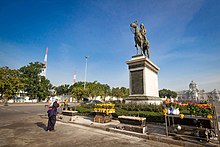
The Royal Plaza in Dusit District was inspired by King Chulalongkorn's visits to Europe.
Bangkok's historic centre remains the Rattanakosin Island in Phra Nakhon District. It is the site of the Grand Palace and the City Pillar Shrine, primary landmarks of the city's foundation, as well as many important Buddhist temples. Phra Nakhon, along with the neighbouring Pom Prap Sattru Phai and Samphanthawong Districts, formed what was the city proper in the later 19th century. Many traditional neighbourhoods and markets are located here, including the Chinese settlement of Sampheng. The city was expanded toward Dusit District in the early 19th century, following King Chulalongkorn's relocation of the royal household to the new Dusit Palace. The buildings of the palace, including the neoclassical Ananta Samakhom Throne Hall, as well as the Royal Plaza and Ratchadamnoen Avenue which leads to it from the Grand Palace, reflect the heavy influence of European architecture at the time. Major government offices line the avenue, as does the Democracy Monument. The area is the site of the country's seats of power as well as the city's most popular tourist landmarks.
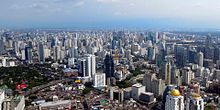
The Sukhumvit area appears as a sea of high-rise buildings in this photograph taken from Baiyoke Tower II, the second tallest building in Bangkok.
In contrast with the low-rise historic areas, the business district on Si Lom and Sathon Roads in Bang Rak and Sathon Districts teems with skyscrapers. It is the site of many of the country's major corporate headquarters, but also of some of the city's infamous red-light districts. The Siam and Ratchaprasong areas in Pathum Wan are home to some of the largest shopping malls in Southeast Asia. Numerous retail outlets and hotels also stretch along Sukhumvit Road leading southeast through Watthana and Khlong Toei Districts. More office towers line the streets branching off Sukhumvit, especially Asok Montri, while upmarket housing span many of its sois.
Bangkok lacks a single distinct central business district. Instead, the areas of Siam and Ratchaprasong serve as a "central shopping district" containing many of the bigger malls and commercial areas in the city, as well as Siam Station, the only transfer point between the city's two elevated train lines.[49] The Victory Monument in Ratchathewi District is among its most important road junctions, serving over 100 bus lines as well as an elevated train station. From the monument, Phahonyothin and Ratchawithi / Din Daeng Roads respectively run northward and eastward linking to major residential areas. Most high-density development is located within the 113-square-kilometre (44 sq mi) area encircled by the Ratchadaphisek inner ring road. Ratchadaphisek is lined with businesses and retail outlets, and office buildings also concentrate around Ratchayothin Intersection in Chatuchak District to the north. Farther from the city centre, most areas are primarily mid- or low-density residential. The Thonburi side of the city is less developed, with fewer high rises. With the exception of a few secondary urban centres, Thonburi, as well as the outlying eastern districts, consist mostly of residential and rural areas.
While most of Bangkok's streets are fronted by vernacular shophouses, the largely unrestricted building frenzy of the 1980s has transformed the city into an urban jungle of skyscrapers and high rises exhibiting contrasting and clashing styles.[50] There are 581 skyscrapers over 90 metres (300 feet) tall in the city. Bangkok was ranked as the world's 8th tallest city in 2016.[51] On the other hand, as a result of economic disparity, many slums have emerged in the city. In 2000 there were over 1 million people living in about 800 slum settlements.[52] A large number of slums are concentrated near the Bangkok Port in Khlong Toei District.
Parks and green zones
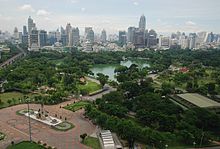
Lumphini Park appears as an oasis of greenery among the skyscrapers of Ratchadamri and Sukhumvit.
Bangkok has several parks, although these amount to a per-capita total park area of only 1.82 square metres (19.6 sq ft) in the city proper. Total green space for the entire city is moderate, at 11.8 square metres (127 sq ft) per person; however, in the more densely built-up areas of the city these numbers are as low as 1.73 and 0.72 square metres (18.6 and 7.8 sq ft) per person.[53] More recent numbers claim that there is only 3.3 m2 of green space per person, compared to an average of 39 m2 in other cities across Asia. In Europe, London has 33.4 m2 of green space per head.[54] Bangkokians thus have 10 times less green space than is standard in the region's urban areas.[55]Green belt areas include about 700 square kilometres (270 sq mi) of rice paddies and orchards in the eastern and western edges of the city proper, although their primary purpose is to serve as flood detention basins rather than to limit urban expansion.[56]Bang Kachao, a 20-square-kilometre (7.7 sq mi) conservation area in an oxbow of the Chao Phraya, lies just across the southern riverbank districts, in Samut Prakan Province. A master development plan has been proposed to increase total park area to 4 square metres (43 sq ft) per person.[53]
Bangkok's largest parks include the centrally located Lumphini Park near the Si Lom – Sathon business district with an area of 57.6 hectares (142 acres), the 80-hectare (200-acre) Suanluang Rama IX in the east of the city, and the Chatuchak–Queen Sirikit–Wachirabenchathat park complex in northern Bangkok, which has a combined area of 92 hectares (230 acres).[57]
Demography
| Year | Population |
|---|---|
| 1919 | 437,294 |
| 1929 | 713,384 |
| 1937 | 890,453 |
| 1947 | 1,178,881 |
| 1960 | 2,136,435 |
| 1970 | 3,077,361 |
| 1980 | 4,697,071 |
| 1990 | 5,882,411 |
| 2000 | 6,355,144 |
| 2010[4] | 8,280,925 |
The city of Bangkok has a population of 8,280,925 according to the 2010 census, or 12.6 percent of the national population.[4] In 2018, the population has been estimated to be about 10 million. Roughly half are internal Thai immigrants from other provinces.[38] Only 5,692,284 residents, belonging to 2,672,423 households, registered Bangkok as their legal domicile.[59] A large number of Bangkok's daytime population commutes from surrounding provinces in the Bangkok Metropolitan Region, the total population of which is 14,565,547. Bangkok is a cosmopolitan city; the census showed that it is home to 81,570 Japanese and 55,893 Chinese nationals, as well as 117,071 expatriates from other Asian countries, 48,341 from Europe, 23,418 from the Americas, 5,289 from Australia and 3,022 from Africa. Immigrants from neighbouring countries include 303,595 Burmese, 63,438 Cambodians and 18,126 Lao.[60] In 2018, numbers show that there are 370,000 international migrants registered with the Department of Employment, more than half of them migrants from Cambodia, Laos, and Myanmar.[38]
Although it has been Thailand's largest population centre since its establishment as capital city in 1782, Bangkok grew only slightly throughout the 18th and early 19th centuries. British diplomat John Crawfurd, visiting in 1822, estimated its population at no more than 50,000.[61] As a result of Western medicine brought by missionaries as well as increased immigration from both within Siam and overseas, Bangkok's population gradually increased as the city modernized in the late 19th century. This growth became even more pronounced in the 1930s, following the discovery of antibiotics. Although family planning and birth control was introduced in the 1960s, the lowered birth rate was more than offset by increased migration from the provinces as economic expansion accelerated. Only in the 1990s have Bangkok's population growth rates decreased, following the national rate. Thailand had long since become highly centralized around the capital. In 1980, Bangkok's population was fifty-one times that of Hat Yai and Songkhla, the second-largest urban centre, making it the world's most prominent primate city.[62]

Yaowarat Road is the centre of Bangkok's Chinatown. Chinese immigrants and their descendants form the largest ethnic group in the city.
The majority of Bangkok's population are of Thai ethnicity,[e] although details on the city's ethnic make-up are unavailable, as the national census does not document race.[f] Bangkok's cultural pluralism dates back to the early days of its foundation; several ethnic communities were formed by immigrants and forced settlers including the Khmer, Northern Thai, Lao, Vietnamese, Tavoyan, Mon and Malay.[10] Most prominent were the Chinese, who played major roles in the city's trade and became the majority of Bangkok's population—estimates include up to three-fourths in 1828 and almost half in the 1950s.[66][g] However, Chinese immigration was restricted from the 1930s and effectively ceased after the Chinese Revolution in 1949. Their prominence subsequently declined as most of younger generations of Thai Chinese have integrated and adopted a Thai identity. Bangkok is still nevertheless home to a large Chinese community, with the greatest concentration in Yaowarat, Bangkok's Chinatown. The majority (91 percent) of the city's population is Buddhist. Other religions include Islam (4.7%), Christianity (2.0%), Hinduism (0.5%), Sikhism (0.1%) and Confucianism (0.1%).[68]
Apart from Yaowarat, Bangkok also has several other distinct ethnic neighbourhoods. The Indian community is centred in Phahurat, where the Gurdwara Siri Guru Singh Sabha, founded in 1933, is located. Ban Khrua on Saen Saep Canal is home to descendants of the Cham who settled in the late 18th century. Although the Portuguese who settled during the Thonburi period have ceased to exist as a distinct community, their past is reflected in Santa Cruz Church, on the west bank of the river. Likewise, the Assumption Cathedral on Charoen Krung Road is among many European-style buildings in the Old Farang Quarter, where European diplomats and merchants lived during the late 19th to early 20th centuries. Nearby, the Haroon Mosque is the centre of a Muslim community. Newer expatriate communities exist along Sukhumvit Road, including the Japanese community near Soi Phrom Phong and Soi Thong Lo, and the Arab and North African neighbourhood along Soi Nana. Sukhumvit Plaza, a mall on Soi Sukhumvit 12, is popularly known as Korea Town.
Economy
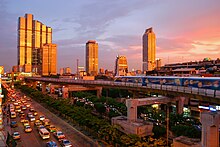
The BTS Skytrain passes through the business district of Sathon. The Robot Building (centre-right) was completed in 1986 and is a symbol of Bangkok's rapid growth in the mid-1980s.
Bangkok is the economic centre of Thailand, and the heart of the country's investment and development. In 2010, the city had an economic output of 3.142 trillion baht (98.34 billion US dollars), contributing 29.1 percent of the gross domestic product (GDP). This amounted to a per-capita GDP value of ฿456,911 ($14,301), almost three times the national average of ฿160,556 ($5,025). The Bangkok Metropolitan Region had a combined output of ฿4.773tn ($149.39bn), or 44.2 percent of GDP.[69] Bangkok's economy ranks as the sixth among Asian cities in terms of per-capita GDP, after Singapore, Hong Kong, Tokyo, Osaka–Kobe and Seoul.[70]
Wholesale and retail trade is the largest sector in the city's economy, contributing 24.0 percent of Bangkok's gross provincial product. It is followed by manufacturing (14.3%); real estate, renting and business activities (12.4%); transport and communications (11.6%); and financial intermediation (11.1%). Bangkok alone accounts for 48.4 percent of Thailand's service sector, which in turn constitutes 49.0 percent of GDP. When the Bangkok Metropolitan Region is considered, manufacturing is the most significant contributor at 28.2 percent of the gross regional product, reflecting the density of industry in the Bangkok's neighbouring provinces.[71]The automotive industry based around Greater Bangkok is the largest production hub in Southeast Asia.[72] Tourism is also a significant contributor to Bangkok's economy, generating ฿427.5bn ($13.38bn) in revenue in 2010.[73]

Outside view of MBK Center
The Stock Exchange of Thailand (SET) is located on Ratchadaphisek Road in inner Bangkok. The SET, together with the Market for Alternative Investment (MAI) has 648 listed companies as of the end of 2011, with a combined market capitalization of 8.485 trillion baht ($267.64bn).[74] Due to the large amount of foreign representation, Thailand has for several years been a mainstay of the Southeast Asian economy and a centre of Asian business. The Globalization and World Cities Research Network ranks Bangkok as an "Alpha−" world city, and it is ranked 59th in Z/Yen's Global Financial Centres Index 11.[75][76]
Bangkok is home to the headquarters of all of Thailand's major commercial banks and financial institutions, as well as the country's largest companies. A large number of multinational corporations base their regional headquarters in Bangkok due to the lower cost of the workforce and firm operations relative to other major Asian business centres. Seventeen Thai companies are listed on the Forbes 2000, all of which are based in the capital,[77] including PTT, the only Fortune Global 500 company in Thailand.[78]
Income inequality is a major issue in Bangkok, especially between relatively unskilled lower-income immigrants from rural provinces and neighbouring countries, and middle-class professionals and business elites. Although absolute poverty rates are low—only 0.64 percent of Bangkok's registered residents were living under the poverty line in 2010, compared to a national average of 7.75—economic disparity is still substantial.[79] The city has a Gini coefficient of 0.48, indicating a high level of inequality.[80]
Tourism
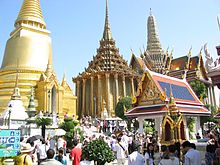
Wat Phra Kaeo in the Grand Palace is among Bangkok's major tourist attractions.
Bangkok is one of the world's top tourist destinations. Of 162 cities worldwide, MasterCard ranked Bangkok as the top destination city by international visitor arrivals in its Global Destination Cities Index 2018, ahead of London, with just over 20 million overnight visitors in 2017.[81] This was a repeat of its 2017 ranking (for 2016).[82][83] Euromonitor International ranked Bangkok fourth in its Top City Destinations Ranking for 2016.[84] Bangkok was also named "World's Best City" by Travel + Leisure magazine's survey of its readers for four consecutive years, from 2010 to 2013.[85]
As the main gateway through which visitors arrive in Thailand, Bangkok is visited by the majority of international tourists to the country. Domestic tourism is also prominent. The Department of Tourism recorded 26,861,095 Thai and 11,361,808 foreign visitors to Bangkok in 2010. Lodgings were made by 15,031,244 guests, who occupied 49.9 percent of the city's 86,687 hotel rooms.[73] Bangkok also topped the list as the world's most popular tourist destinations in 2017 rankings.[86][87][88][89]
Bangkok's multi-faceted sights, attractions and city life appeal to diverse groups of tourists. Royal palaces and temples as well as several museums constitute its major historical and cultural tourist attractions. Shopping and dining experiences offer a wide range of choices and prices. The city is also famous for its dynamic nightlife. Although Bangkok's sex tourism scene is well known to foreigners, it is usually not openly acknowledged by locals or the government.
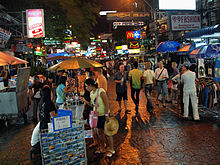
Khao San Road is lined by budget accommodation, shops and bars catering to tourists.
Among Bangkok's well-known sights are the Grand Palace and major Buddhist temples, including Wat Phra Kaew, Wat Pho, and Wat Arun. The Giant Swing and Erawan Shrine demonstrate Hinduism's deep-rooted influence in Thai culture. Vimanmek Mansion in Dusit Palace is famous as the world's largest teak building, while the Jim Thompson House provides an example of traditional Thai architecture. Other major museums include the Bangkok National Museum and the Royal Barge National Museum. Cruises and boat trips on the Chao Phraya and Thonburi's canals offer views of some of the city's traditional architecture and ways of life on the waterfront.[90]
Shopping venues, many of which are popular with both tourists and locals, range from the shopping centres and department stores concentrated in Siam and Ratchaprasong to the sprawling Chatuchak Weekend Market. Taling Chan Floating Market is among the few such markets in Bangkok. Yaowarat is known for its shops as well as street-side food stalls and restaurants, which are also found throughout the city. Khao San Road has long been famous as a backpackers' destination, with its budget accommodation, shops and bars attracting visitors from all over the world.
Bangkok has a reputation overseas as a major destination in the sex industry. Although prostitution is technically illegal and is rarely openly discussed in Thailand, it commonly takes place among massage parlours, saunas and hourly hotels, serving foreign tourists as well as locals. Bangkok has acquired the nickname "Sin City of Asia" for its level of sex tourism.[91]
Issues often encountered by foreign tourists include scams, overcharging and dual pricing. In a survey of 616 tourists visiting Thailand, 7.79 percent reported encountering a scam, the most common of which was the gem scam, in which tourists are tricked into buying overpriced jewellery.[92]
Culture
The culture of Bangkok reflects its position as Thailand's centre of wealth and modernisation. The city has long been the portal of entry of Western concepts and material goods, which have been adopted and blended with Thai values to various degrees by its residents. This is most evident in the lifestyles of the expanding middle class. Conspicuous consumption serves as a display of economic and social status, and shopping centres are popular weekend hangouts.[93] Ownership of electronics and consumer products such as mobile phones is ubiquitous. This has been accompanied by a degree of secularism, as religion's role in everyday life has rather diminished. Although such trends have spread to other urban centres, and, to a degree, the countryside, Bangkok remains at the forefront of social change.
A distinct feature of Bangkok is the ubiquity of street vendors selling goods ranging from food items to clothing and accessories. It has been estimated that the city may have over 100,000 hawkers. While the BMA has authorised the practice in 287 sites, the majority of activity in another 407 sites takes place illegally. Although they take up pavement space and block pedestrian traffic, many of the city's residents depend on these vendors for their meals, and the BMA's efforts to curb their numbers have largely been unsuccessful.[94]
In 2015, however, the BMA, with support from the National Council for Peace and Order (Thailand's ruling military junta), began cracking down on street vendors in a bid to reclaim public space. Many famous market neighbourhoods were affected, including Khlong Thom, Saphan Lek, and the flower market at Pak Khlong Talat. Nearly 15,000 vendors were evicted from 39 public areas in 2016.[95] While some applauded the efforts to focus on pedestrian rights, others have expressed concern that gentrification would lead to the loss of the city's character and adverse changes to people's way of life.[96][97]
Festivals and events

Ratchadamnoen Avenue is annually decorated with lights and displays in celebration of the king's birthday.
The residents of Bangkok celebrate many of Thailand's annual festivals. During Songkran on 13–15 April, traditional rituals as well as water fights take place throughout the city. Loi Krathong, usually in November, is accompanied by the Golden Mount Fair. New Year celebrations take place at many venues, the most prominent being the plaza in front of CentralWorld. Observances related to the royal family are held primarily in Bangkok. Wreaths are laid at King Chulalongkorn's equestrian statue in the Royal Plaza on 23 October, which is King Chulalongkorn Memorial Day. The present king's and queen's birthdays, respectively on 5 December and 12 August, are marked as Thailand's national Father's Day and national Mother's Day. These national holidays are celebrated by royal audiences on the day's eve, in which the king or queen gives a speech, and public gatherings on the day of the observance. The king's birthday is also marked by the Royal Guards' parade.
Sanam Luang is the site of the Thai Kite, Sport and Music Festival, usually held in March, and the Royal Ploughing Ceremony which takes place in May. The Red Cross Fair at the beginning of April is held at Suan Amporn and the Royal Plaza, and features numerous booths offering goods, games and exhibits. The Chinese New Year (January–February) and Vegetarian Festival (September–October) are celebrated widely by the Chinese community, especially in Yaowarat.[98]
Media
Bangkok is the centre of Thailand's media industry. All national newspapers, broadcast media and major publishers are based in the capital. Its 21 national newspapers had a combined daily circulation of about two million in 2002. These include the mass-oriented Thai Rath, Khao Sod and Daily News, the first of which currently prints a million copies per day,[99] as well as the less sensational Matichon and Krungthep Thurakij. The Bangkok Post and The Nation are the two national English language dailies. Foreign publications including The Asian Wall Street Journal, Financial Times, The Straits Times and the Yomiuri Shimbun also have operations in Bangkok.[100] The large majority of Thailand's more than 200 magazines are published in the capital, and include news magazines as well as lifestyle, entertainment, gossip and fashion-related publications.
Bangkok is also the hub of Thailand's broadcast television. All six national terrestrial channels, Channels 3, 5 and 7, Modernine, NBT and Thai PBS, have headquarters and main studios in the capital. With the exception of local news segments broadcast by the NBT, all programming is done in Bangkok and repeated throughout the provinces. However, this centralised model is weakening with the rise of cable television, which has many local providers. There are numerous cable and satellite channels based in Bangkok. TrueVisions is the major subscription television provider in Bangkok and Thailand, and it also carries international programming. Bangkok was home to 40 of Thailand's 311 FM radio stations and 38 of its 212 AM stations in 2002.[100] Broadcast media reform stipulated by the 1997 Constitution has been progressing slowly, although many community radio stations have emerged in the city.
Likewise, Bangkok has dominated the Thai film industry since its inception. Although film settings normally feature locations throughout the country, the city is home to all major film studios. Bangkok has dozens of cinemas and multiplexes, and the city hosts two major film festivals annually, the Bangkok International Film Festival and the World Film Festival of Bangkok.
Art
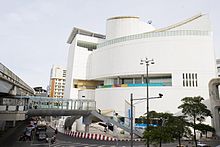
Bangkok Art and Culture Centre, the city's major public contemporary art venue, was opened in 2008 after many delays.
Traditional Thai art, long developed within religious and royal contexts, continues to be sponsored by various government agencies in Bangkok, including the Department of Fine Arts' Office of Traditional Arts. The SUPPORT Foundation in Chitralada Palace sponsors traditional and folk handicrafts. Various communities throughout the city still practice their traditional crafts, including the production of khon masks, alms bowls, and classical musical instruments. The National Gallery hosts permanent collection of traditional and modern art, with temporary contemporary exhibits. Bangkok's contemporary art scene has slowly grown from relative obscurity into the public sphere over the past two decades. Private galleries gradually emerged to provide exposure for new artists, including the Patravadi Theatre and H Gallery. The centrally located Bangkok Art and Culture Centre, opened in 2008 following a fifteen-year lobbying campaign, is now the largest public exhibition space in the city.[101] There are also many other art galleries and museums, including the privately owned Museum of Contemporary Art.
The city's performing arts scene features traditional theatre and dance as well as Western-style plays. Khon and other traditional dances are regularly performed at the National Theatre and Salachalermkrung Royal Theatre, while the Thailand Cultural Centre is a newer multi-purpose venue which also hosts musicals, orchestras and other events. Numerous venues regularly feature a variety of performances throughout the city.
Sport
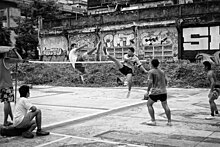
Games of sepak takraw can be spotted throughout Bangkok's parks and streets.
Modern Bangkok has developed a strong spectator sport culture. While muay Thai kickboxing matches at Rajadamnern and Lumpini Stadiums are regularly broadcast on television, the sport has mostly been overtaken in popularity by association football. Several foreign leagues and competitions, especially England's Premier League, have large followings in Bangkok as well as other Thai urban centres. In recent years, the Thai League has been gaining popularity. Police Tero based in Bangkok and Muangthong United based in the Bangkok Metropolitan Region are leading clubs.[102] For more information on this topic, see Football in Bangkok.
While sepak takraw can be seen played in open spaces throughout the city, especially by the working class, football and other modern sports are now more of the norm. Western sports were introduced during the reign of King Chulalongkorn, and were originally only available to the privileged. Such status is still associated with certain sports. Golf is popular among the upwardly mobile, and while Thailand's more famous clubs are in the countryside, there are several courses in Bangkok itself. Horse riding takes place in a couple of exclusive clubs in the city. Horse racing is very popular in Bangkok and betting on horses is legal. There are two racecourses in Bangkok: "Royal Bangkok Sports Club" and "Royal Turf Club of Thailand".
There are many public sporting facilities located throughout Bangkok. The two main centres are the National Stadium complex, which dates to 1938, and the newer Hua Mak Sports Complex, which was built for the 1998 Asian Games. Bangkok had also hosted the games in 1966, 1970 and 1978; the most of any city. The city was the host of the inaugural Southeast Asian Games in 1959, the 2007 Summer Universiade and the 2012 FIFA Futsal World Cup.
Transport

Streetlamps and headlights illuminate the Makkasan Interchange of the expressway. The system sees a traffic of over 1.5 million vehicles per day.[103]
Although Bangkok's canals historically served as a major mode of transport, they have long since been surpassed in importance by land traffic. Charoen Krung Road, the first to be built by Western techniques, was completed in 1864. Since then, the road network has vastly expanded to accommodate the sprawling city. A complex elevated expressway network helps bring traffic into and out of the city centre, but Bangkok's rapid growth has put a large strain on infrastructure, and traffic jams have plagued the city since the 1990s. Although rail transport was introduced in 1893 and electric trams served the city from 1894 to 1968, it was only in 1999 that Bangkok's first rapid transit system began operation. Older public transport systems include an extensive bus network and boat services which still operate on the Chao Phraya and two canals. Taxis appear in the form of cars, motorcycles, and "tuk-tuk" auto rickshaws.
Bangkok is connected to the rest of the country through the national highway and rail networks, as well as by domestic flights to and from the city's two international airports. Its centuries-old maritime transport of goods is still conducted through Khlong Toei Port.
The BMA is largely responsible for overseeing the construction and maintenance of the road network and transport systems through its Public Works Department and Traffic and Transportation Department. However, many separate government agencies are also in charge of the individual systems, and much of transport-related policy planning and funding is contributed to by the national government.
Roads
Road-based transport is the primary mode of travel in Bangkok. Due to the city's organic development, its streets do not follow an organized grid structure. Forty-eight major roads link the different areas of the city, branching into smaller streets and lanes (soi) which serve local neighbourhoods. Eleven bridges over the Chao Phraya link the two sides of the city, while several expressway and motorway routes bring traffic into and out of the city centre and link with nearby provinces.

Traffic jams, seen here on Ratchadamri Road, are common in Bangkok.
Bangkok's rapid growth in the 1980s resulted in sharp increases in vehicle ownership and traffic demand, which have since continued—in 2006 there were 3,943,211 in-use vehicles in Bangkok, of which 37.6 percent were private cars and 32.9 percent were motorcycles.[104] These increases, in the face of limited carrying capacity, caused severe traffic congestion evident by the early 1990s. The extent of the problem is such that the Thai Traffic Police has a unit of officers trained in basic midwifery in order to assist deliveries which do not reach hospital in time.[105] While Bangkok's limited road surface area (8 percent, compared to 20–30 percent in most Western cities) is often cited as a major cause of its traffic jams, other factors, including high vehicle ownership rate relative to income level, inadequate public transport systems, and lack of transportation demand management, also play a role.[106] Efforts to alleviate the problem have included the construction of intersection bypasses and an extensive system of elevated highways, as well as the creation of several new rapid transit systems. The city's overall traffic conditions, however, remain poor.
Traffic has been the main source of air pollution in Bangkok, which reached serious levels in the 1990s. But efforts to improve air quality by improving fuel quality and enforcing emission standards, among others, had visibly ameliorated the problem by the 2000s. Atmospheric particulate matter levels dropped from 81 micrograms per cubic metre in 1997 to 43 in 2007.[107] However, increasing vehicle numbers and a lack of continued pollution-control efforts threatens a reversal of the past success.[108] In January–February 2018, weather conditions caused bouts of haze to cover the city, with particulate matter under 2.5 micrometres (PM2.5) rising to unhealthy levels for several days on end.[109][110]
Although the BMA has created thirty signed bicycle routes along several roads totalling 230 kilometres (140 mi),[111] cycling is still largely impractical, especially in the city centre. Most of these bicycle lanes share the pavement with pedestrians. Poor surface maintenance, encroachment by hawkers and street vendors, and a hostile environment for cyclists and pedestrians, make cycling and walking unpopular methods of getting around in Bangkok.
Buses and taxis
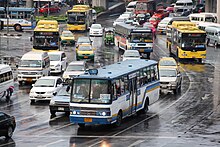
A large number of buses, minibuses and taxis share the streets with private vehicles at Victory Monument, a major public transport hub.
Bangkok has an extensive bus network providing local transit services within the Greater Bangkok area. The Bangkok Mass Transit Authority (BMTA) operates a monopoly on bus services, with substantial concessions granted to private operators. Buses, minibus vans, and song thaeo operate on a total of 470 routes throughout the region.[112] A separate bus rapid transit system owned by the BMA has been in operation since 2010. Known simply as the BRT, the system currently consists of a single line running from the business district at Sathon to Ratchaphruek on the western side of the city. The Transport Co., Ltd. is the BMTA's long-distance counterpart, with services to all provinces operating out of Bangkok.
Taxis are ubiquitous in Bangkok, and are a popular form of transport. As of August 2012[update], there are 106,050 cars, 58,276 motorcycles and 8,996 tuk-tuk motorized tricycles cumulatively registered for use as taxis.[113] Meters have been required for car taxis since 1992, while tuk-tuk fares are usually negotiated. Motorcycle taxis operate from regulated ranks, with either fixed or negotiable fares, and are usually employed for relatively short journeys.
Despite their popularity, taxis have gained a bad reputation for often refusing passengers when the requested route is not to the driver's convenience.[114] Motorcycle taxis were previously unregulated, and subject to extortion by organized crime gangs. Since 2003, registration has been required for motorcycle taxi ranks, and drivers now wear distinctive numbered vests designating their district of registration and where they are allowed to accept passengers.
Rail systems
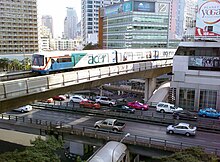
A BTS train passes over the busy Sala Daeng Intersection. The MRT also crosses below the street at this location.
Bangkok is the location of Hua Lamphong Railway Station, the main terminus of the national rail network operated by the State Railway of Thailand (SRT). In addition to long-distance services, the SRT also operates a few daily commuter trains running from and to the outskirts of the city during the rush hour.
Bangkok is currently served by three rapid transit systems: the BTS Skytrain, the underground MRT and the elevated Airport Rail Link. Although proposals for the development of rapid transit in Bangkok had been made since 1975,[115] it was only in 1999 that the BTS finally began operation.
The BTS consists of two lines, Sukhumvit and Silom, with thirty-four stations along 30.95 kilometres (19.23 mi).[needs update] The MRT opened for use in July 2004, and currently consists of two lines, the Blue Line and Purple Line. The Airport Rail Link, opened in August 2010, connects the city centre to Suvarnabhumi Airport to the east. Its eight stations span a distance of 28 kilometres (17 mi).
Although initial passenger numbers were low and their service area remains limited to the inner city, these systems have become indispensable to many commuters. The BTS reported an average of 600,000 daily trips in 2012,[116] while the MRT had 240,000 passenger trips per day.[117]
As of 2016[update], construction work is ongoing to extend BTS and MRT, as well as several additional transit lines, including the Light Red grade-separated commuter rail line. The entire Mass Rapid Transit Master Plan in Bangkok Metropolitan Region consists of eight main lines and four feeder lines totalling 508 kilometres (316 mi) to be completed by 2029. In addition to rapid transit and heavy rail lines, there have been proposals for several monorail systems.
Water transport
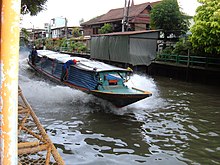
The Khlong Saen Saep water bus serves over 50,000 passengers daily.
Although much diminished from its past prominence, water-based transport still plays an important role in Bangkok and the immediate upstream and downstream provinces. Several water buses serve commuters daily. The Chao Phraya Express Boat serves thirty-four stops along the river, carrying an average of 35,586 passengers per day in 2010, while the smaller Khlong Saen Saep boat service serves twenty-seven stops on Saen Saep Canal with 57,557 daily passengers. Long-tail boats operate on fifteen regular routes on the Chao Phraya, and passenger ferries at thirty-two river crossings served an average of 136,927 daily passengers in 2010.[118]
Bangkok Port, popularly known by its location as Khlong Toei Port, was Thailand's main international port from its opening in 1947 until it was superseded by the deep-sea Laem Chabang Port in 1991. It is primarily a cargo port, though its inland location limits access to ships of 12,000 deadweight tonnes or less. The port handled 11,936,855 tonnes (13,158,130 tons) of cargo in the first eight months of the 2010 fiscal year, about 22 percent the total of the country's international ports.[119][120]
Airports
Bangkok is one of Asia's busiest air transport hubs. Two commercial airports serve the city, the older Don Mueang International Airport and the new Bangkok International Airport, commonly known as Suvarnabhumi. Suvarnabhumi, which replaced Don Mueang as Bangkok's main airport after its opening in 2006, served 52,808,013 passengers in 2015,[121] making it the world's 20th busiest airport by passenger volume. This volume exceeded its designed capacity of 45 million passengers. Don Mueang reopened for domestic flights in 2007,[122] and resumed international service focusing on low-cost carriers in October 2012.[123] Suvarnabhumi is undergoing expansion to increase its capacity to 60 million passengers by 2019 and 90 million by 2021.[124]
Health and education
Education
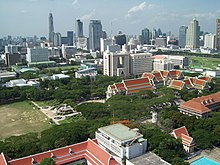
The campus of Chulalongkorn University was surrounded by rural fields when it was established in 1917. Pathum Wan District has since become part of the Bangkok city centre.
Bangkok has long been the centre of modern education in Thailand. The first schools in the country were established here in the later 19th century, and there are now 1,351 schools in the city.[125] The city is home to the country's five oldest universities, Chulalongkorn, Thammasat, Kasetsart, Mahidol and Silpakorn, founded between 1917 and 1943. The city has since continued its dominance, especially in higher education; the majority of the country's universities, both public and private, are located in Bangkok or the Metropolitan Region. Chulalongkorn and Mahidol are the only Thai universities to appear in the top 500 of the QS World University Rankings.[126]King Mongkut's University of Technology Thonburi, also located in Bangkok, is the only Thai university in the top 400 of the 2012–13 Times Higher Education World University Rankings.[127]
Over the past few decades the general trend of pursuing a university degree has prompted the founding of new universities to meet the needs of Thai students. Bangkok became not only a place where immigrants and provincial Thais go for job opportunities, but also for a chance to receive a university degree. Ramkhamhaeng University emerged in 1971 as Thailand's first open university; it now has the highest enrolment in the country. The demand for higher education has led to the founding of many other universities and colleges, both public and private. While many universities have been established in major provinces, the Greater Bangkok region remains home to the greater majority of institutions, and the city's tertiary education scene remains over-populated with non-Bangkokians. The situation is not limited to higher education, either. In the 1960s, 60 to 70 percent of 10- to 19-year-olds who were in school had migrated to Bangkok for secondary education. This was due to both a lack of secondary schools in the provinces and perceived higher standards of education in the capital.[128] Although this discrepancy has since largely abated, tens of thousands of students still compete for places in Bangkok's leading schools. Education has long been a prime factor in the centralization of Bangkok and will play a vital role in the government's efforts to decentralize the country.
Healthcare

Siriraj Hospital, established in 1888, is the oldest hospital in Thailand.
Much of Thailand's medical resources are disproportionately concentrated in the capital. In 2000, Bangkok had 39.6 percent of the country's doctors and a physician-to-population ratio of 1:794, compared to a median of 1:5,667 among all provinces.[129] The city is home to 42 public hospitals, five of which are university hospitals, as well as 98 private hospitals and 4,063 registered clinics.[dead link][130] The BMA operates nine public hospitals through its Medical Service Department, and its Health Department provides primary care through sixty-eight community health centres. Thailand's universal healthcare system is implemented through public hospitals and health centres as well as participating private providers.
Research-oriented medical school affiliates such as Siriraj, King Chulalongkorn Memorial and Ramathibodi Hospitals are among the largest in the country, and act as tertiary care centres, receiving referrals from distant parts of the country. Lately, especially in the private sector, there has been much growth in medical tourism, with hospitals such as Bumrungrad and Bangkok Hospital, among others, providing services specifically catering to foreigners. An estimated 200,000 medical tourists visited Thailand in 2011, making Bangkok the most popular global destination for medical tourism.[131]
Crime and safety
Bangkok has a relatively moderate crime rate when compared to urban counterparts around the world.[132] Traffic accidents are a major hazard, while natural disasters are rare.[citation needed] Intermittent episodes of political unrest and occasional terrorist attacks have resulted in losses of life.[citation needed]
Although the crime threat in Bangkok is relatively low, non-confrontational crimes of opportunity such as pick-pocketing, purse-snatching, and credit card fraud occur with frequency.[132] Bangkok's growth since the 1960s has been followed by increasing crime rates partly driven by urbanisation, migration, unemployment and poverty.[citation needed] By the late 1980s, Bangkok's crime rates were about four times that of the rest of the country.[citation needed] The police have long been preoccupied with street crimes ranging from housebreaking to assault and murder.[133] The 1990s saw the emergence of vehicle theft and organized crime, particularly by foreign gangs.[134] Drug trafficking, especially that of ya ba methamphetamine pills, is also chronic.[citation needed]
According to police statistics, the most common complaint received by the Metropolitan Police Bureau in 2010 was housebreaking, with 12,347 cases. This was followed by 5,504 cases of motorcycle thefts, 3,694 cases of assault and 2,836 cases of embezzlement. Serious offences included 183 murders, 81 gang robberies, 265 robberies, 1 kidnapping and 9 arson cases. Offences against the state were by far more common, and included 54,068 drug-related cases, 17,239 cases involving prostitution and 8,634 related to gambling.[135] The Thailand Crime Victim Survey conducted by the Office of Justice Affairs of the Ministry of Justice found that 2.7 percent of surveyed households reported a member being victim of a crime in 2007. Of these, 96.1 percent were crimes against property, 2.6 percent were crimes against life and body, and 1.4 percent were information-related crimes.[136]
Political demonstrations and protests are common in Bangkok.[citation needed] While most events since 1992 had been peaceful, the series of protests since 2006 have often turned violent.[citation needed] Demonstrations during March–May 2010 ended in a crackdown in which 92 were killed, including armed and unarmed protesters, security forces, civilians and journalists. Terrorist incidents have also occurred in Bangkok, most notably the 2015 Bangkok bombing at the Erawan shrine, and also a series of bombings on the 2006–07 New Year's Eve.
Traffic accidents are a major hazard in Bangkok. There were 37,985 accidents in the city in 2010, resulting in 16,602 injuries and 456 deaths as well as 426.42 million baht in damages. However, the rate of fatal accidents is much lower than in the rest of Thailand. While accidents in Bangkok amounted to 50.9 percent of the entire country, only 6.2 percent of fatalities occurred in the city.[137] Another serious public health hazard comes from Bangkok's stray dogs. Up to 300,000 strays are estimated to roam the city's streets,[138] and dog bites are among the most common injuries treated in the emergency departments of the city's hospitals. Rabies is prevalent among the dog population, and treatment for bites pose a heavy public burden.[h]
International relations
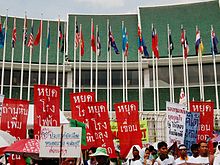
Protesters in front of the United Nations Building during the 2009 Bangkok Climate Change Conference—Bangkok is home to several UN offices.
The city's formal international relations are managed by the International Affairs Division of the BMA. Its missions include facilitating cooperation with other major cities through sister city agreements, participation and membership in international organizations, and pursuing cooperative activities with the many foreign diplomatic missions based in the city.[140]
International participation
Bangkok is a member of several international organizations and regional city government networks, including the Asian Network of Major Cities 21, the Japan-led Asian-Pacific City Summit, the C40 Cities Climate Leadership Group, the ESCAP-sponsored Regional Network of Local Authorities for Management of Human Settlements in Asia and Pacific (CITYNET), Japan's Council of Local Authorities for International Relations, the World Association of the Major Metropolises and Local Governments for Sustainability, among others.[140]
With its location at the heart of mainland Southeast Asia and as one of Asia's hubs of transportation, Bangkok is home to many international and regional organizations. Among others, Bangkok is the seat of the Secretariat of the UN Economic and Social Commission for Asia and the Pacific (ESCAP), as well as the Asia-Pacific regional offices of the Food and Agricultural Organization (FAO), the International Civil Aviation Organization (ICAO), the International Labour Organization (ILO), the International Organization for Migration (IOM), the International Telecommunication Union (ITU), the UN High Commission for Refugees (UNHCR), and the UN Children's Fund (UNICEF).[141]
Sister cities
Bangkok's sister cities as of 2018[update] are:[142]
|
|
See also
 Bangkok portal
Bangkok portal
- Outline of Bangkok
- World's largest cities
Notes
^ Two plants are known in Thai by the name makok: E. hygrophilus (makok nam, "water makok") and Spondias pinnata (makok pa, "jungle makok"). The species that grew in the area was likely makok nam.
^ While this ceremonial name is generally believed, based on writings by the Somdet Phra Wannarat (Kaeo), to have originally been given by King Rama I and later modified by King Mongkut, it did not come into use until the latter reign.[15]
^ This ceremonial name uses two ancient Indian languages, Pāli and Sanskrit, prefaced with the only one Thai word, Krung, which means 'capital'. According to the romanisation of these languages, it can actually be written as Krung-dēvamahānagara amararatanakosindra mahindrāyudhyā mahātilakabhava navaratanarājadhānī purīramya uttamarājanivēsana mahāsthāna amaravimāna avatārasthitya shakrasdattiya vishnukarmaprasiddhi (listen) (help·info).
(listen) (help·info).
^ The BMA gives an elevation figure of 2.31 metres (7 ft 7 in).[1]
^ Thai ethnicity is rather a question of cultural identity than of genetic origin.[63] Many people in Bangkok who self-identify as Thai have at least some Chinese ancestry.[64]
^ An introductory publication by the BMA gives a figure of 80% Thai, 10% Chinese and 10% others, although this is likely a rough estimate.[65]
^ By one recent estimate, at least 60 percent of the city's residents are of Chinese descent.[67]
^ A 1993 study found dog bites to constitute 5.3 percent of injuries seen at Siriraj Hospital's emergency department.[139]
References
^ abcde Thavisin et al. (eds) 2006, p. 24. Reproduced in "Geography of Bangkok". BMA website. Archived from the original on 5 July 2011. Retrieved 8 September 2007..mw-parser-output cite.citation{font-style:inherit}.mw-parser-output q{quotes:"""""""'""'"}.mw-parser-output code.cs1-code{color:inherit;background:inherit;border:inherit;padding:inherit}.mw-parser-output .cs1-lock-free a{background:url("//upload.wikimedia.org/wikipedia/commons/thumb/6/65/Lock-green.svg/9px-Lock-green.svg.png")no-repeat;background-position:right .1em center}.mw-parser-output .cs1-lock-limited a,.mw-parser-output .cs1-lock-registration a{background:url("//upload.wikimedia.org/wikipedia/commons/thumb/d/d6/Lock-gray-alt-2.svg/9px-Lock-gray-alt-2.svg.png")no-repeat;background-position:right .1em center}.mw-parser-output .cs1-lock-subscription a{background:url("//upload.wikimedia.org/wikipedia/commons/thumb/a/aa/Lock-red-alt-2.svg/9px-Lock-red-alt-2.svg.png")no-repeat;background-position:right .1em center}.mw-parser-output .cs1-subscription,.mw-parser-output .cs1-registration{color:#555}.mw-parser-output .cs1-subscription span,.mw-parser-output .cs1-registration span{border-bottom:1px dotted;cursor:help}.mw-parser-output .cs1-hidden-error{display:none;font-size:100%}.mw-parser-output .cs1-visible-error{font-size:100%}.mw-parser-output .cs1-subscription,.mw-parser-output .cs1-registration,.mw-parser-output .cs1-format{font-size:95%}.mw-parser-output .cs1-kern-left,.mw-parser-output .cs1-kern-wl-left{padding-left:0.2em}.mw-parser-output .cs1-kern-right,.mw-parser-output .cs1-kern-wl-right{padding-right:0.2em}
^ ab Tangchonlatip, Kanchana (2007). "กรุงเทพมหานคร: เมืองโตเดี่ยวตลอดกาลของประเทศไทย" [Bangkok: Thailand's forever primate city]. In Thongthai, Varachai; Punpuing, Sureeporn. ประชากรและสังคม 2550 [Population and society 2007]. Nakhon Pathom, Thailand: Institute for Population and Social Research. Retrieved 26 September 2012.
^ ab Sinsakul, Sin (August 2000). "Late Quaternary geology of the Lower Central Plain, Thailand". Journal of Asian Earth Sciences. 18 (4): 415–426. doi:10.1016/S1367-9120(99)00075-9. Retrieved 22 May 2014.
^ abc "Table 1 Population by sex, household type and household by type, average size of private household by region and area: 2010". Statistic tables, NSO website. National Statistics Office. Retrieved 18 September 2012.
^ ab "Thailand: Division (Planning Regions and Provinces) - Population Statistics, Charts and Map". citypopulation.de. Retrieved 8 December 2017.
^ "Bangkok". British and World English Dictionary. Oxford Dictionaries. Retrieved 4 August 2017.
^ ab "Definition of "Bangkok"". Collins English Dictionary (online). HarperCollins. Retrieved 26 March 2014.
^ "Bangkok". US English Dictionary. Oxford Dictionaries. Retrieved 4 August 2017.
^ ab Chandrashtitya, Tipawan; Matungka, Chiraporn. ประวัติเมืองธนบุรี [History of Thonburi City]. Arts & Cultural Office (in Thai). Dhonburi Rajabhat University. Archived from the original on 13 July 2010. Retrieved 11 December 2011.
^ abcd Committee for the Rattanakosin Bicentennial Celebration (1982). จดหมายเหตุการอนุรักษ์กรุงรัตนโกสินทร์ [Rattanakosin City conservation archives]. Department of Fine Arts. Reproduced in "กว่าจะมาเป็นกรุงเทพฯ" [The path to become Bangkok]. BMA Data Center. Archived from the original on 19 December 2014. Retrieved 1 August 2012.
^ Baker & Pongpaichit 2005, pp. 37–41, 45, 52–71, 149–150, 162, 199–204.
^ พจนานุกรม ฉบับราชบัณฑิตยสถาน พ.ศ. ๒๕๔๒ [Royal Institute Dictionary, B.E. 1999 (online edition)] (in Thai). Royal Institute. Archived from the original on 12 November 2013. Retrieved 12 September 2012.
^ Wongthes, Sujit (2012). Archived copy กรุงเทพฯ มาจากไหน? [Bangkok: A Historical Background] (in Thai). Bangkok: Dream Catcher. p. 37. ISBN 9786167686004. Archived from the original on 17 December 2014. Retrieved 9 June 2013.CS1 maint: Archived copy as title (link)
^ สาระน่ารู้กรุงธนบุรี [Interesting facts about the city of Thonburi]. Phra Racha Wang Derm (in Thai). Phra Racha Wang Derm Restoration Foundation. Archived from the original on 2 March 2012. Retrieved 11 December 2011.
^ ab Phakathikhom, Chanchai (2005). นามพระนคร "ศรีอยุธยา" มาแต่ไหน [What were the origins of the capital name "Si Ayutthaya"?] (PDF). Senathipat (in Thai). 54 (3): 114–123. ISSN 0857-3891. Retrieved 31 July 2013.
[permanent dead link]
^ Roberts, Edmund (1837) [1837]. "Chapter XVIII —City of Bang-kok". Embassy to the Eastern courts of Cochin-China, Siam, and Muscat: in the U. S. sloop-of-war Peacock during the years 1832–3–4. Harper & Brothers. p. image 288. OCLC 12212199. Retrieved 5 April 2013.The spot on which the present capital stands, and the country in its vicinity, on both banks of the river for a considerable distance, were formerly, before the removal of the court to its present situation called Bang-kok; but since that time, and for nearly sixty years past, it has been named Sia yuthia, (pronounced See-ah you-tè-ah, and by the natives, Krung, that is, the capital;) it is called by both names here, but never Bang-kok; and they always correct foreigners when the latter make this mistake. The villages which occupy the right hand of the river, opposite to the capital, pass under the general name of Bang-kok.
^ "กรุงเทพมหานคร". Royal Institute Newsletter. 3 (31). December 1993. Reproduced in กรุงเทพมหานคร [Krung Thep Mahanakhon] (in Thai). Archived from the original on 2016-12-10. Retrieved 12 September 2012.
^ "Record Application Search". Guinness World Records. Retrieved 2016-12-02. (Registration required (help)).
^ Thavisin et al. (eds) 2006, p. 86.
^ "คำสั่งหัวหน้าคณะรักษาความสงบแห่งชาติ ที่ ๖๔/๒๕๕๙ เรื่อง การให้ผู้ว่าราชการกรุงเทพมหานครพ้นจากตำแหน่ง และการแต่งตั้งผู้ว่าราชการกรุงเทพมหานคร" (PDF). Royal Gazette (in Thai). 133 (พิเศษ 238 ง): 9–10. 2016-10-18.
^ Thavisin et al. (eds) 2006, pp. 80–82.
^ Thavisin et al. (eds) 2006, p. 78.
^ Department of National Parks, Wildlife and Plant Conservation. ไทรย้อยใบแหลม [Golden fig]. DNP website (in Thai). Retrieved 25 September 2012.
^ "Bangkok Finally Gets Its Own Provincial Slogan" (PDF). Bangkok Inter News. 5 (2): 10. April–June 2012. Archived from the original (PDF) on 16 October 2015.
^ "The largest cities in the world by land area, population and density". City Mayors. 6 January 2007. Archived from the original on 18 July 2008. Retrieved 19 July 2008.
^ Smyth, H. Warrington (1898). Five years in Siam: from 1891 to 1896. II. New York: Charles Scribner's Sons. p. 9. Quoted in Baker & Phongpaichit 2005, p. 90.
^ Thavisin et al. (eds) 2006, p. 35.
^ Phien-wej, N.; Giao, P.H.; Nutalaya, P (2 February 2006). "Land subsidence in Bangkok, Thailand". Engineering Geology. 82 (4): 187–201. doi:10.1016/j.enggeo.2005.10.004. Retrieved 22 May 2014.
^ "Rising seas, sinking land threaten Thai capital". CNN International. Archived from the original on 30 October 2007. Retrieved 24 October 2007.
^ Philip, Bruno (21 Jul 2011). "Thailand, Sinking: Parts of Bangkok Could Be Underwater in 2030". Time.
^ Sattaburuth, Aekarach (2015-07-23). "Bangkok 'could be submerged in 15 years'". Bangkok Post. Retrieved 23 January 2017.
^ Engkagul, Surapee (1993). "Flooding features in Bangkok and vicinity: Geographical approach". GeoJournal. 31 (4): 335–8. doi:10.1007/BF00812783 (inactive 2018-09-19).
^ Nicholls, R. J.; Hanson, S.; Herweijer, C.; Patmore, N.; Hallegatte, S.; CorfeeMorlot, J.; Chateau, Jean; Muir-Wood, Robert (2008). "Ranking Port Cities with High Exposure and Vulnerability to Climate Extremes: Exposure Estimates" (PDF). OECD Environment Working Papers (1). doi:10.1787/011766488208. Retrieved 22 May 2014.
^ Old photo (around 1900) of dilapidated prang from the collection of Cornell University Library (last access 2009-09-24).
^ "Phu Khao Thong (Golden Mount)". wikimapia.org.
^ Climatological Group, Meteorological Development Bureau (January 2012). "The Climate of Thailand" (PDF). Thai Meteorological Department. Retrieved 26 September 2012.
^ Tran, Hung; Uchihama, Daisuke; Ochi, Shiro; Yasuoka, Yoshifumi (January 2006). "Assessment with satellite data of the urban heat island effects in Asian mega cities". International Journal of Applied Earth Observation and Geoinformation. 8 (1): 34–48. doi:10.1016/j.jag.2005.05.003. Retrieved 22 May 2014.
^ abc Wangkiat, Paritta (15 July 2018). "Strong Cities Needed" (in Spectrum). Bangkok Post. Retrieved 16 July 2018.
^ Thai Meteorological Department. "Extreme minimum temperature during winter season in Thailand 60-year period (1951–2010)" (PDF). TMD website.
^ Popovich, Nadja; Migliozzi, Blacki; Taylor, Rumsey; Williams, Josh; Watkins, Derek (n.d.). "How Much Hotter Is Your Hometown Than When You Were Born?" (Interactive graphic). New York Times. NASA Goddard Institute for Space Studies. Retrieved 1 September 2018.
^ "Climatological Data for the Period 1981–2010". Thai Meteorological Department. pp. 16–17. Retrieved 31 July 2016.
^ "ปริมาณการใช้น้ำของพืชอ้างอิงโดยวิธีของ Penman Monteith (Reference Crop Evapotranspiration by Penman Monteith)" (PDF). Office of Water Management and Hydrology, Royal Irrigation Department. Retrieved 9 June 2014.
^ "แผนการบริหารจัดการน้ำและการเพาะปลูกพืชฤดูแล้งในเขตชลประทาน ปี 2556/2557" (PDF). Retrieved 10 June 2014.
^ "Climate of Bangkok" (in Russian). Weather and Climate (Погода и климат). Retrieved 8 October 2014.
^ "Climate Normals for Bangkok". National Oceanic and Atmospheric Administration. Retrieved 4 November 2018.
^ Department of Provincial Administration, Ministry of Interior, Royal Thai Government. As of December 2009 (in Thai) Archived 2011-02-06 at the Wayback Machine.
^ Krongkaew, Medhi (1996). "The changing urban system in a fast-growing city and economy: The case of Bangkok and Thailand". In Lo, Fu-chen; Yeung, Yue-man. Emerging World Cities in Pacific Asia. United Nations University Press. p. 322. ISBN 978-92-808-0907-7.
^ City Planning Department. "History". CPD website. City Planning Department. Archived from the original on 1 January 2013. Retrieved 25 September 2012.
^ McGrath, Brian (2005). "Bangkok's CSD". In Benites, Cecilia; Lyster, Clare. Regarding Public Space. New York, NY: Princeton Architectural Press. pp. 46–53. ISBN 978-156898544-2.
^ Hamilton 2000, pp. 465–466.
^ "The World's Best Skylines".
^ Pornchokchai, Sopon (2003). "Global report on human settlements 2003 – City report: Bangkok" (PDF).
^ ab Thaiutsa, Bunvong; Puangchit, Ladawan; Kjelgren, Roger; Arunpraparut, Wanchai (1 August 2008). "Urban green space, street tree and heritage large tree assessment in Bangkok, Thailand". Urban Forestry & Urban Greening. 7 (3): 219–229. doi:10.1016/j.ufug.2008.03.002. Retrieved 22 May 2014.
^ "Tower project 'suspicious'" (Editorial). Bangkok Post. 2017-07-01. Retrieved 1 July 2017.
^ "A shopping complex, or a 'green lung'". The Nation. 2015-05-13. Retrieved 13 May 2015.
^ Yokohari, Makoto; Takeuchi, Kazuhiko; Watanabe, Takashi; Yokota, Shigehiro (10 April 2000). "Beyond greenbelts and zoning: A new planning concept for the environment of Asian mega-cities". Landscape and Urban Planning. 47 (3–4): 159–171. doi:10.1016/S0169-2046(99)00084-5. Retrieved 22 May 2014.
^ Public Park Office, Environment Department. "Public Park Office website". Bangkok Metropolitan Administration. Retrieved 18 September 2012.CS1 maint: Uses authors parameter (link)
^ Statistical Forecasting Bureau (2010). 2010 Thailand Statistical Yearbook (Special edition) (PDF). National Statistical Office.
^ "รายงานสถิติจำนวนประชากรและบ้าน ประจำปี พ.ศ. 2557 (Population and household statistics, 2014)". Department of Provincial Administration. Retrieved 30 July 2015.
^ "Table 5 Population by nationality, region and area: 2010". Statistic tables, NSO website. National Statistics Office. Retrieved 18 September 2012.
^ Crawfurd, John (1830). Journal of an embassy from the governor-general of India to the courts of Siam and Cochin China; exhibiting a view of the actual state of those kingdoms. 2. London: H. Colburn and R. Bentley. p. 215.
^ Sternstein, Larry (March 1984). "The growth of the population of the world's pre-eminent "primate city": Bangkok at its bicentenary". Journal of Southeast Asian Studies. 15 (1): 43–68. doi:10.1017/S0022463400012200. PMID 12266027.
^ Thak Chaloemtiarana (2007), Thailand: The Politics of Despotic Paternalism, Ithaca, NY: Cornell Southeast Asia Program, pp. 245–246, ISBN 978-0-8772-7742-2
^ Askew, Marc (2004). Bangkok: Place, Practice and Representation. p. 38. ISBN 978-1134659869.
^ Thavisin et al. (eds) 2006, p. 7.
^ Caldwell, John C. (1967). "The Demographic Structure". In Silcock, T.H. Thailand, Social and Economic Studies in Development. Canberra: Australian National University Press. pp. 29–33. and Skinner, G. William (1957). Chinese Society in Thailand: An Analytical History. Ithaca, NY: Cornell University Press. pp. 17–18. cited in Goldstein, Sidney (August 1972). The Demography of Bangkok: A case study of differentials between big city and rural populations (PDF). Research reports. Bangkok: Institute of Population Studies, Chulalongkorn University. p. 32. Archived from the original (PDF) on 31 July 2013.
^ Chen, Jennifer (20 March 2007). "Shophouses: Reviving the distinctive face of Bangkok" – via NYTimes.com.
^ "Table 4 Population by religion, region and area: 2010". Statistic tables, NSO website. National Statistics Office. Retrieved 18 September 2012.
^ NESDB 2012, pp. 26, 39–40, 48–49, 62–63, 218–219.
^ Naudin (ed.) 2010, p. 85.
^ NESDB 2012, pp.48–49, 62–63, 218–219.
^ Naudin (ed.) 2010, p. 83.
^ ab "Internal tourism in Bangkok" (PDF). Department of Tourism. Archived from the original (PDF) on 7 December 2013. Retrieved 22 September 2012.
^ Stock Exchange of Thailand 2012, pp. 22, 25.
^ Globalization and World Cities Research Network. "The World According to GaWC 2010". GaWC website. Loughborough University. Retrieved 26 September 2012.
^ Yeandle, Mark (March 2012). The Global Financial Centres Index 11 (PDF). Long Finance. p. 5. ISBN 978-0-9546207-7-6. Archived from the original (PDF) on 19 March 2012. Retrieved 25 September 2012.
^ "The World's Biggest Public Companies". Forbes.com. Forbes.com LLC. April 2012. Retrieved 25 September 2012.
^ "Fortune's annual ranking of the world's largest corporations". cnn.com. CNN. July 2012. Retrieved 23 July 2012.
^ "ตารางที่ 1.2 สัดส่วนคนจนด้านรายจ่าย จำแนกตามภาคและพื้นที่ ปี พ.ศ. 2531–2553 (Poverty rates by expenses, sorted by region and area, 1988–2010)". Social and Quality of Life Database System (in Thai). Office of the National Economic and Social Development Board. 26 September 2011. Retrieved 25 September 2012.
^ Moreno, Eduardo López; Oyeyinka, Oyebanji; Mboup, Gora (2008). State of the World's Cities 2010/2011 – Cities for All: Bridging the Urban Divide. State of the World's Cities. London, Sterling, VA: Earthscan. p. 194. ISBN 978-1-84971-176-0. Archived from the original (PDF) on 23 May 2012. Retrieved 25 September 2012.
^ "Big Cities, Big Business: Bangkok, London and Paris Lead the Way in Mastercard's 2018 Global Destination Cities Index" (Press release). 25 September 2018. Retrieved 2018-10-06.
^ "Bangkok Claims Title as World's Most Visited City: 2016 Mastercard Global Destination Cities Index" (Press release). Mastercard. 2016-09-22.
^ "Defining What Makes a City a Destination (2017 Destination Index)" (Press release). MasterCard. 2017-09-26. Retrieved 6 October 2018.
^ "Top 100 Cities Destination Ranking". Euromonitor International. 21 January 2013. Retrieved 6 June 2013.
^ "2013 World's Best Cities". Travel + Leisure. American Express Publishing Corporation. Retrieved 31 July 2013.
^ Talty, Alexandra (26 September 2017). "Bangkok Named Most Popular City For International Tourists In 2017". Forbes. Retrieved 2 October 2017.
^ Hao, Karen (26 September 2017). "The overwhelming majority of popular tourist destinations are in Asia". Quartz. Retrieved 2 October 2017.
^ Hunter, Marnie (26 September 2017). "10 most popular cities for international travelers in 2017". CNN Travel (Cable News Network). Retrieved 2 October 2017.
^ Morton, Caitlin (26 September 2017). "The ten most visited cites of 2017". Conde Nast Traveler. Retrieved 2 October 2017.
^ Thavisin et al. (eds) 2006, pp. 63–69.
^ Emmons, Ron; Eveland, Jennifer; White, Daniel (28 June 2011). Frommer's Southeast Asia. John Wiley & Sons. p. 79. ISBN 978-1-118-00979-6. Retrieved 8 April 2012.
^ Howard, Robert W. (June 2009). "Risky business? Asking tourists what hazards they actually encountered in Thailand". Tourism Management. 30 (3): 359–365. doi:10.1016/j.tourman.2008.08.007.
^ Hamilton 2000, p. 468.
^ Bhowmik, Sharit K (28 May – 4 June 2005). "Street Vendors in Asia: A Review". Economic and Political Weekly: 2256–2264.
^ Nualkhair, Chawadee (12 February 2017). "Bangkok's street food under threat from gentrification". The Guardian. Retrieved 13 February 2017.
^ Mokkhasen, Sasiwan (5 July 2016). "Vanishing Bangkok: What is the Capital Being Remade Into, And For Whom?". Khaosod English. Retrieved 3 February 2017.
^ Sauers, Craig (23 August 2016). "Bangkok's disappearing street food". BBC Travel. Retrieved 3 February 2017.
^ Thavisin et al. (eds) 2006, p. 72.
^ "ข้อมูลทั่วไป (General information)". Thai Rath Online. Wacharapol. Archived from the original on 11 September 2012. Retrieved 23 September 2012.
^ ab Chongkittavorn, Kavi (2002). "The Media and Access to Information in Thailand". In Islam, Roumeen. The Right to Tell: The Role of Mass Media in Economic Development. WBI Development Studies. Washington, D.C.: The World Bank. pp. 255–266. ISBN 978-0-8213-5203-8.
^ Krich, John (6 March 2009). "Center Stage". The Wall Street Journal. Retrieved 26 September 2012.
^ Post reporters (23 September 2012). "Blemishes in the beautiful game". Bangkok Post.
^ "สรุปรายได้และปริมาณรถ: สิงหาคม 2555 (Revenue and traffic, August 2012)". EXAT website (in Thai). Expressway Authority of Thailand. 4 September 2012. Archived from the original on 23 September 2012. Retrieved 11 September 2012.
^ "Developing Integrated Emission Strategies for Existing Land-transport" (PDF). Clean Air Initiative. Archived from the original (PDF) on 3 June 2013. Retrieved 15 September 2012.
^ "In Bangkok gridlock, Thai traffic police double as midwives". AFP. 17 April 2008. Archived from the original on 27 May 2013. Retrieved 22 September 2012.
^ Tanaboriboon, Yordphol (1993). "Bangkok traffic" (PDF). IATSS Research. 7 (1). Retrieved 15 September 2012.
^ Fuller, Thomas (23 February 2007). "Bangkok's template for an air-quality turnaround". New York Times. Retrieved 15 September 2012.
^ Thin Lei Win (18 May 2017). "Choked by traffic, Bangkok revs up to beat air pollution". Reuters. Retrieved 15 February 2018.
^ Chuwiruch, Natnicha; Suwannakij, Supunnabul (15 February 2018). "There's a New Contender for Title of Asia's Most Polluted City". Bloomberg. Retrieved 15 February 2018.
^ "City smog worsens to danger level". Bangkok Post. 15 February 2018. Retrieved 15 February 2018.
^ Traffic and Transportation Department, p. 154.
^ Traffic and Transportation Department, pp. 112.
^ Transport Statistics Sub-division, Planning Division. "Number of Vehicles Registered in Thailand as of 31 August 2012". Department of Land Transport website. Department of Land Transport. Retrieved 16 September 2012.
^ Sereemongkonpol, Pornchai (14 September 2012). "Bangkok's best taxi drivers". Bangkok Post. Retrieved 16 September 2012.
^ Rujopakarn, Wiroj (October 2003). "Bangkok transport system development: what went wrong?". Journal of the Eastern Asia Society for Transportation Studies. 5: 3302–15.
^ "BTS Group Holdings - The Nation".
^ "New BMCL boss eyes boosting commercial revenue - The Nation".
^ Traffic and Transportation Department, pp. 113–122.
^ Sukdanont, Sumalee (July 2011). "ท่าเรือกรุงเทพ". Transportation Institute, Chulalongkorn University. Archived from the original on 5 March 2013. Retrieved 19 September 2012.
^ "สรุปผลการดำเนินงานของกทท. 8 เดือน ปีงบประมาณ 2553 (ต.ค.52-พ.ค.53)" (PDF). PAT website. Port Authority of Thailand. Archived from the original (PDF) on 20 November 2012. Retrieved 19 September 2012.
^ "2015 Year to date Passenger Traffic". www.aci.aero. Retrieved 2016-12-10.
^ "In With the Old", Aviation Week & Space Technology, 1 January 2007.
^ Mahitthirook, Amornrat (1 October 2012). "Don Mueang airport reopens". Bangkok Post. Retrieved 11 October 2012.
^ "Thai airport operator to spend $5.5 bln on expansion". Reuters Asia. Reuters. Retrieved 19 May 2017.
^ Bureau of Information and Communication Technology, OPS, MOE. Educational Statistics in Brief 2011. Ministry of Education. pp. 28–29. Archived from the original on 10 October 2014. Retrieved 15 June 2014.CS1 maint: Uses authors parameter (link)
^ "QS World University Rankings". QS Quacquarelli Symonds Limited. Retrieved 26 September 2012.
^ "King Mongkut's University of Technology, Thonburi". Times Higher Education World University Rankings. TSL Education. Retrieved 20 April 2013.
^ Nitungkorn, Sukanya (June 1988). "The problems of secondary education expansion in Thailand" (PDF). Southeast Asian Studies. 26 (1). Retrieved 22 September 2012.
^ Nishiura, Hiroshi; Barua, Sujan; Lawpoolsri, Saranath; Kittitrakul, Chatporn; Leman, Martinus Martin; Maha, Masri Sembiring; Muangnoicharoen, Sant (3 September 2004). "Health inequalities in Thailand: geographic distribution of medical supplies in the provinces" (PDF). Southeast Asian Journal of Tropical Medicine and Public Health. 35 (3): 735–40. PMID 15689097. Archived from the original (PDF) on 3 March 2016.
^ "สถิติสถานพยาบาลเอกชน ปี 2554 (Private healthcare provider statistics, 2011)". Medical Registration Division, Department of Health Service Support, Ministry of Public Health. Archived from the original (Microsoft Excel spreadsheet) on 1 May 2013. Retrieved 15 September 2012.
^ Eden, Caroline (4 September 2012). "The rise of medical tourism in Bangkok". BBC. Retrieved 22 September 2012.
^ ab This article incorporates public domain material from the Overseas Security Advisory Council document: "Thailand 2012 Crime and Safety Report: Bangkok". Overseas Security Advisory Council website. Bureau of Diplomatic Security, U.S. Department of State. 14 March 2012. Retrieved 24 September 2012.
This article incorporates public domain material from the Overseas Security Advisory Council document: "Thailand 2012 Crime and Safety Report: Bangkok". Overseas Security Advisory Council website. Bureau of Diplomatic Security, U.S. Department of State. 14 March 2012. Retrieved 24 September 2012.
^ Watanavanich, Prathan (1995). "Urban Crime in the Changing Thai Society: The Case of Bangkok Metropolis". In Miyazawa, Koichi; Miyazawa, Setsuo. Crime Prevention in the Urban Community. Deventer, The Netherlands: Kluwer Law and Taxation Publishers. pp. 193–210.
^ Davis, Antony (13 October 2000). "Bangkok as Crime Central". Asiaweek. 26 (40). Retrieved 24 September 2012.
^ สถิติคดีอาญา 5 กลุ่ม ปี 2553 [5-group criminal case statistics, 2010]. สถิติคดีอาญา (Criminal case statistics) (in Thai). Office of Information and Communication Technology, Royal Thai Police. Archived from the original (XLS) on 27 August 2011. Retrieved 24 September 2012.
^ "ข้อมูลสถิติอาชญากรรมภาคประชาชนในกรุงเทพมหานคร (Crime victim statistics, Bangkok)" (PDF). Thailand Crime Victim Survey, 2007. Office of Justice Affairs. Archived from the original (PDF) on 4 September 2015. Retrieved 24 September 2012.
^ Traffic and Transportation Department, pp. 138–144.
^ "Stray Dogs Overwhelming Bangkok". National Geographic. National Geographic Society. AP. 8 June 2009. Retrieved 24 September 2012.
^ Bhanganada, Kasian; Wilde, Henry; Sakolsataydorn, Piyasakol; Oonsombat, Pairoj (December 1993). "Dog-bite injuries at a Bangkok teaching hospital". Acta Tropica. 55 (4): 249–255. doi:10.1016/0001-706X(93)90082-M.
^ ab International Affairs Division. "Project Plan". International Affairs Division website. International Affairs Division, Bangkok Metropolitan Administration. Retrieved 12 September 2012.
^ "UN Offices in Thailand". United Nations Thailand website. United Nations Thailand. Archived from the original on 16 April 2012. Retrieved 9 May 2012.
^ "Relationship with Sister Cities". International Affairs Office, BMA. Retrieved 12 February 2018.
^ District of Columbia; Bangkok Metropolitan Administration (19 February 1962). "Resolution: Sister City Affiliation of Washington, D.C. and Bangkok, Thailand" (PDF).
^ District of Columbia; Bangkok Metropolitan Administration (15 July 2002). "Reaffirmation agreement between Washington, D.C. and Bangkok, Thailand" (PDF).
^ Bangkok Metropolitan Administration (26 May 1993). "Agreement on the Establishment of Sister City Relations between Bangkok Metropolitan Administration of the Kingdom of Thailand and the Beijing Municipality of the People's Republic of China" (PDF).
^ Bangkok Metropolitan Administration; Local Government of Budapest (20 February 1997). "Letter of Intent of Cooperation between Bangkok Metropolitan Administration (BMA) and Local Government of Budapest" (PDF).
^ Bangkok Metropolitan Administration; City of Brisbane (7 May 1997). "Memorandum of Understanding between the City of Bangkok, The Kingdom of Thailand and the City of Brisbane, Queensland, Australia" (PDF).
^ Bangkok Metropolitan Administration; City of Moscow (19 June 1997). "Protocol of friendly ties between the cities of Bangkok and Moscow" (PDF).
^ "St. Petersburg in figures – International and Interregional Ties". Eng.gov.spb.ru. Archived from the original on 24 February 2009. Retrieved 27 June 2010.
^ Bangkok Metropolitan Administration; City of St.Petersburg (20 June 1997). "Protocol on Cooperation between the City of Bangkok (the Kingdom of Thailand) and the City of St. Petersburg (the Russian Federation)" (PDF).
^ "Existing Sister Cities". City of Manila. Archived from the original on 6 August 2009. Retrieved 2 September 2009.
^ Bangkok Metropolitan Administration; City of Manila (24 June 1997). "Sister city friendship affiliation".
^ Bangkok Metropolitan Administration; Jakarta Capital City Administration (21 January 2002). "Memorandum of understanding between Bangkok Metropolitan Administration, Kingdom of Thailand and the Jakarta Capital City Administration, Republic of Indonesia concerning sister city cooperation" (PDF).
^ Hanoi Capital City; Bangkok Metropolitan Administration (25 February 2004). "Agreement on cooperative and friendship relations between Hanoi Capital City and Bangkok Metropolitan Administration" (PDF).
^ City of Vientiane; Bangkok Metropolitan Administration (24 May 2004). "บันทึกว่าด้วยความร่วมมือ ระหว่างนครหลวงเวียงจันทน์และกรุงเทพมหานคร" (PDF).
^ Akimat of Astana City; Bangkok Metropolitan Administration (11 June 2004). "Agreement on establishment of bilateral relations between the Akimat of Astana City of the Republic of Kazakhstan and the City of Bangkok of Kingdom Thailand" (PDF).
^ "Agreement of Sister City Relations". Office.bangkok.go.th. Archived from the original on 1 May 2011. Retrieved 27 June 2010.
^ Chaozhou City; Bangkok Metropolitan Administration (23 November 2005). "Agreement between Chaozhou City, the People's Republic of China and Bangkok, Kingdom of Thailand on the Establishment of Sister City Relations" (PDF).
^ International Affairs Division. "Relationship with Sister Cities: Fukuoka". International Affairs Division website. International Affairs Division, Bangkok Metropolitan Administration. Retrieved 12 September 2012.
^ Seoul Metropolitan Government; Bangkok Metropolitan Administration (16 June 2006). "Sister City Agreement between the Seoul Metropolitan Government, Republic of Korea and the Bangkok Metropolitan Administration, the Kingdom of Thailand" (PDF).
^ "Guangzhou Sister Cities [via WaybackMachine.com]". Guangzhou Foreign Affairs Office. Archived from the original on 24 October 2012. Retrieved 21 July 2013.
^ Bangkok Metropolitan Administration; City of Guanzhou (13 November 2009). "Agreement on the establishment of sister city relations between Bangkok, Kingdom of Thailand and City of Guangzhou, the People's Republic of China" (PDF).
^ City of Lausanne; Bangkok Metropolitan Administration (29 December 2009). "Accord de fraternité entre La Ville de Lausanne Capitale du Canton de Vaud Confédération Helvétique et La Ville de Bangkok Royaume de Thaïlande" (PDF).
^ Busan Metropolitan City; Bangkok Metropolitan Administration (14 March 2011). "Busan Metropolitan City – Bangkok Metropolitan Administration Agreement on the Establishment of a Friendship City Relationship" (PDF).
^ Chonqing Municipality; Bangkok Metropolitan Administration (26 September 2011). "Agreement between Chonqing Municipality of the People's Republic of China and Bangkok Metropolitan Administration of the Kingdom of Thailand on the establishment of sister-city relationship" (PDF).
^ Tianjin Municipal Government; Bangkok Metropolitan Administration (27 February 2012). "Agreement between Tianjin Municipal Government of the People's Republic of China and Bangkok Metropolitan Administration of the Kingdom of Thailand on the establishment of friendship exchanges and cooperative relationship" (PDF).
^ Bangkok Metropolitan Administration; Greater Ankara Municipality (21 March 2012). "Friendship and cooperation agreement between Bangkok Metropolitan Administration of the Kingdom of Thailand and the Greater Ankara Municipality of the Republic of Turkey" (PDF).
^ "Kardeş Kentleri Listesi ve 5 Mayıs Avrupa Günü Kutlaması [via WaybackMachine.com]" (in Turkish). Ankara Büyükşehir Belediyesi – Tüm Hakları Saklıdır. Archived from the original on 14 January 2009. Retrieved 21 July 2013.
^ Municipal Council of Penang Island; Bangkok Metropolitan Administration (5 April 2012). "Memorandum of understanding between Municipal Council of Penang Island of Malaysia and Bangkok Metropolitan Administration of the Kingdom of Thailand on the establishment of friendly cities" (PDF).
^ International Affairs Division. "Relationship with Sister Cities: Aichi". International Affairs Division website. International Affairs Division, Bangkok Metropolitan Administration. Retrieved 12 September 2012.
^ Xinhua. "Cambodia's Phnom Penh, Thailand's Bangkok become "sister cities"". Global Times. Retrieved 4 January 2013.
^ "wuhan's sister city increased to 24". english.wh.gov.cn. 21 November 2013. Archived from the original on 22 November 2016. Retrieved 21 November 2016.
^ The City of Lisbon; Bangkok Metropolitan Administration (19 July 2016). "Friendship And Co-Operation Agreement between The City of Lisbon, Portuguese Republic and The Bangkok Metropolitan Administration Kingdom of Thailand" (PDF).
^ นครเฉิงตู สาธารณรัฐประชาชนจีน. bangkok.go.th
Bibliography
Baker, Chris; Phongpaichit, Pasuk (2005). A History of Thailand. Cambridge University Press. ISBN 978-0-521-01647-6.
Hamilton, Annette (2000). "Wonderful, Terrible: Everyday Life in Bangkok". In Bridge, Gary; Vatson, Sophie. A Companion to the City. Blackwell Publishing. pp. 460–471. ISBN 978-0-631-23578-1.
Naudin, Thierry, ed. (2010). The State of Asian Cities 2010/11 (PDF). United Nations Human Settlements Programme. ISBN 978-92-1-132274-3. Archived from the original (PDF) on 19 January 2013. Retrieved 25 September 2012.
Office of the National Economic and Social Development Board (NESDB) (August 2012). Gross Regional and Provincial Product chain volume measures 1995–2010 edition. Office of the National Economic and Social Development Board. Archived from the original (ZIP/PDF) on 4 February 2013. Retrieved 25 September 2012.
Thavisin, Nathanon; Semson, Pongsak; Padhanarath, Kriengpol, eds. (2006). Your Key to Bangkok. Bangkok: International Affairs Division, Bangkok Metropolitan Administration. ISBN 978-974-9565-72-8. Archived from the original on 2 October 2013.
Traffic and Transportation Department (2011). สถิติจราจร ปี 2553 (Traffic statistics, 2010) (PDF). Traffic and Transportation Department, Bangkok Metropolitan Administration.
Further reading
Van Beek, Steve (2018). News from the 90s; Bangkok 1890-1899. Bangkok: ปิยวีร์ รื่นจินดา. ISBN 9786169317104. Retrieved 2018-11-24.
External links
- Bangkok Metropolitan Administration official website
- bangkoktourist.com - Official travel guide by the BMA Culture, Sports and Tourism Department
- Tourism Authority of Thailand (Bangkok)





